April 2025 News
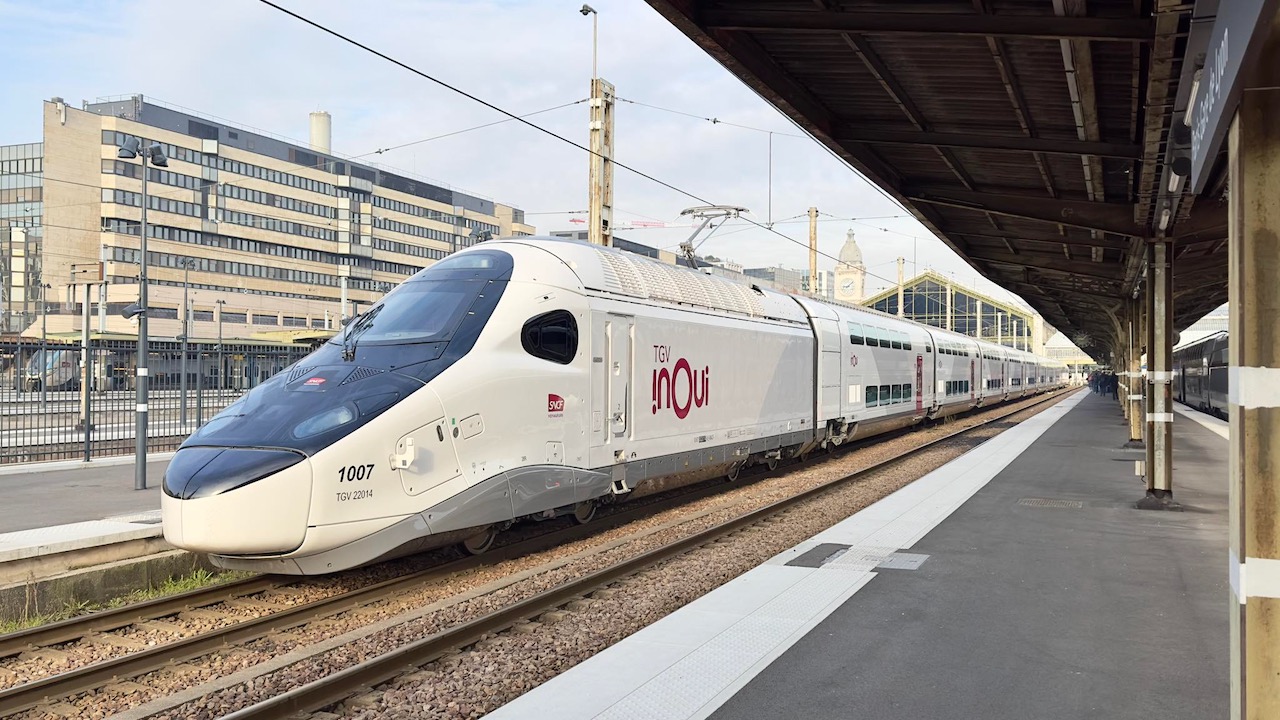
TGV M interiors revealed
SNCF Voyageurs and builder Alstom unveiled TGV M at Paris Gare de Lyon on 11 March, at the same time consigning the M (for modular) to history. The fifth-generation TGV is to be known from now on as TGV Inoui, the branding currently used for all TGVs apart from the low-cost Ouigo offer. Four coaches of nine-car Set 1007 were shown to the press, one all first class, one second class upstairs and first downstairs, a third was second class upstairs with PMR (persons with reduced mobility) accessible accommodation downstairs, while the fourth was the bistro car. The ‘flowing’ interior of the new train is by French design agency Arep and Japanese firm Nendo. David Haydock attended the presentation and this report is based on his observations.
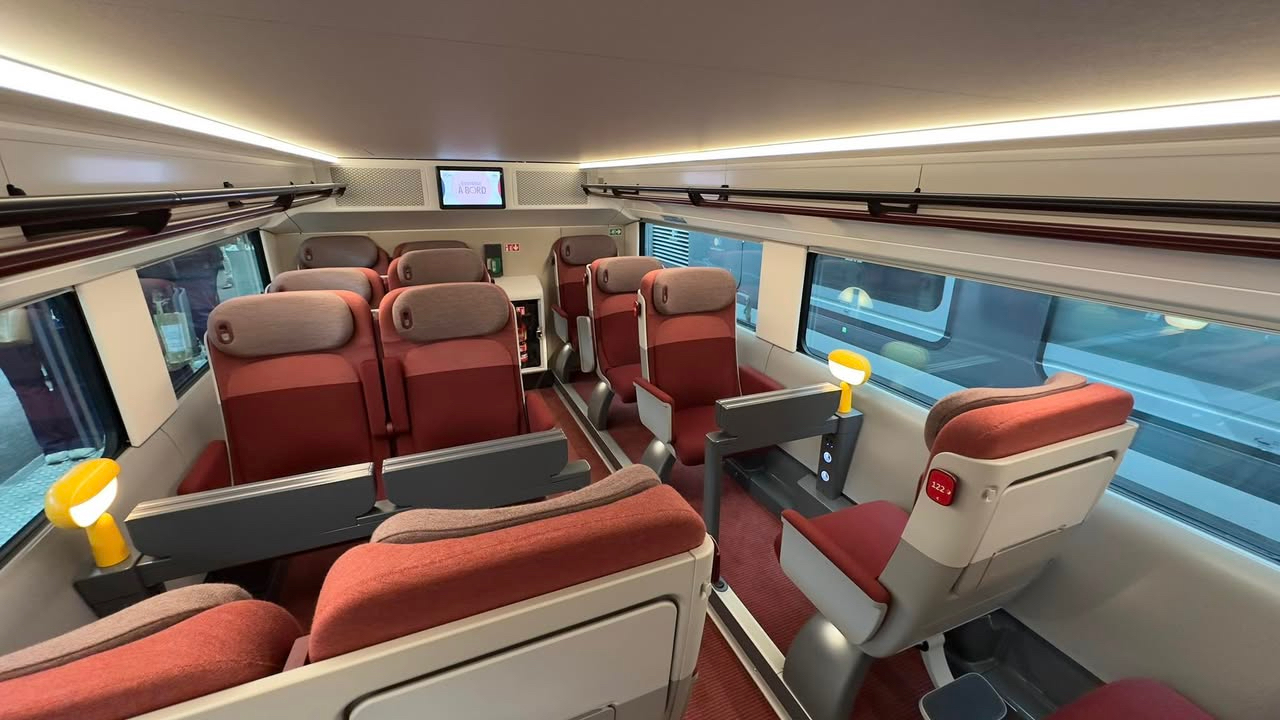
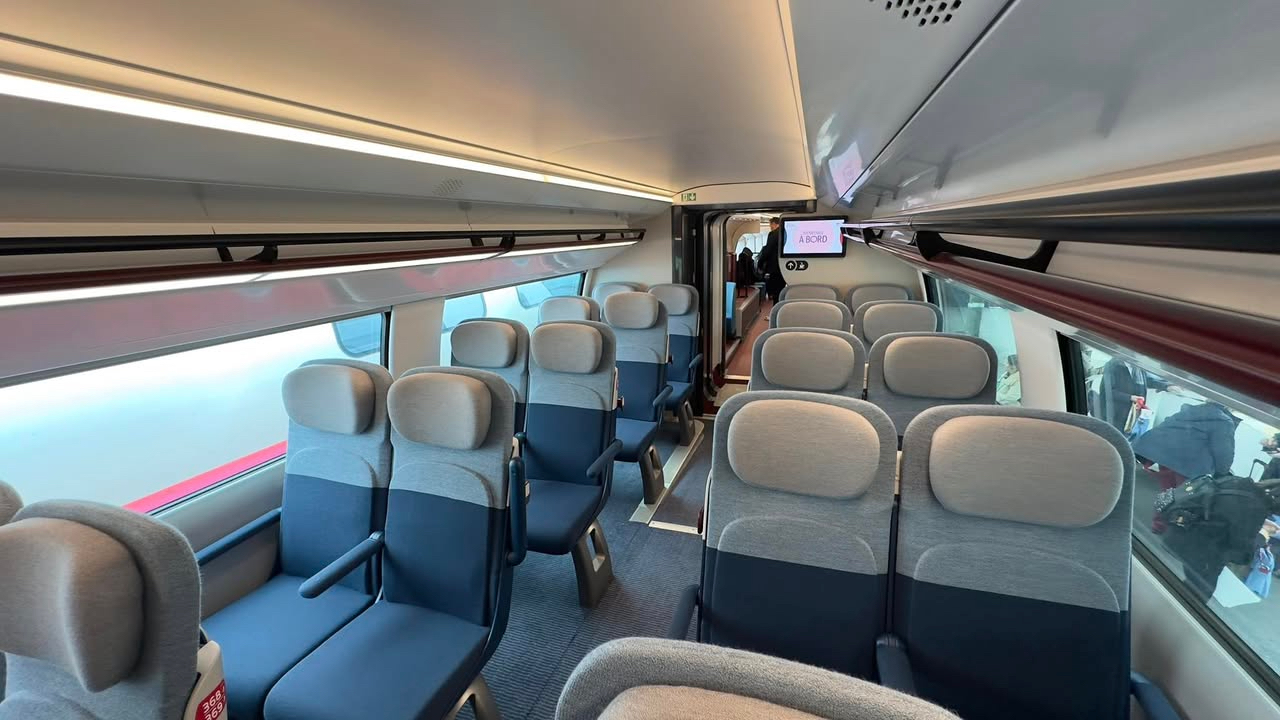
The first feeling on entering TGV M is its similarity with the most recent Euroduplex sets – l’Océane version used mainly on Atlantique services. One very positive aspect of the new design is the bigger windows and reduction in pillar-width between them, which means that almost everyone has a view despite seats not aligning with windows. Most doors between vestibules and saloons have been removed, freeing-up a little space and letting passengers see their luggage. The Océane version is unpopular with some passengers upstairs because they are forced to leave bags outside the saloon where they are not visible. Ironically SNCF regularly tells passengers to keep an eye on their bags. This will certainly be possible in the new trains, the luggage racks being open-ended (and rather ugly). However, the lack of doors means people cannot use their phones in the vestibules (as requested) without annoying other passengers; draughts could be a problem too. A really bad feature throughout the train is the racks above the seats which are too narrow to be useful.
Seats are to a new design and all have reading lights. There is a good deal of space under the seats as SNCF now asks passengers to store smaller bags there, which will reduce legroom. First-class seats are 5cm wider than the previous generation. Seat-back tables open to reveal a magazine rack, plus electricity and USB sockets. The second coach on show had second-class accommodation upstairs and first downstairs, the latter having room for two bikes. Second-class seating is generous, with 5cm more legroom than in L’Océane, and seats with similar facilities to first class, albeit arranged 2 + 2 instead of 2 + 1. Toilets are larger than before and those on the upper level have natural light from a small window. Lighting and HVAC throughout the train adjusts automatically according to load-factor and conditions outside. Aircon is claimed to cope with exterior temperature up to 50degC.
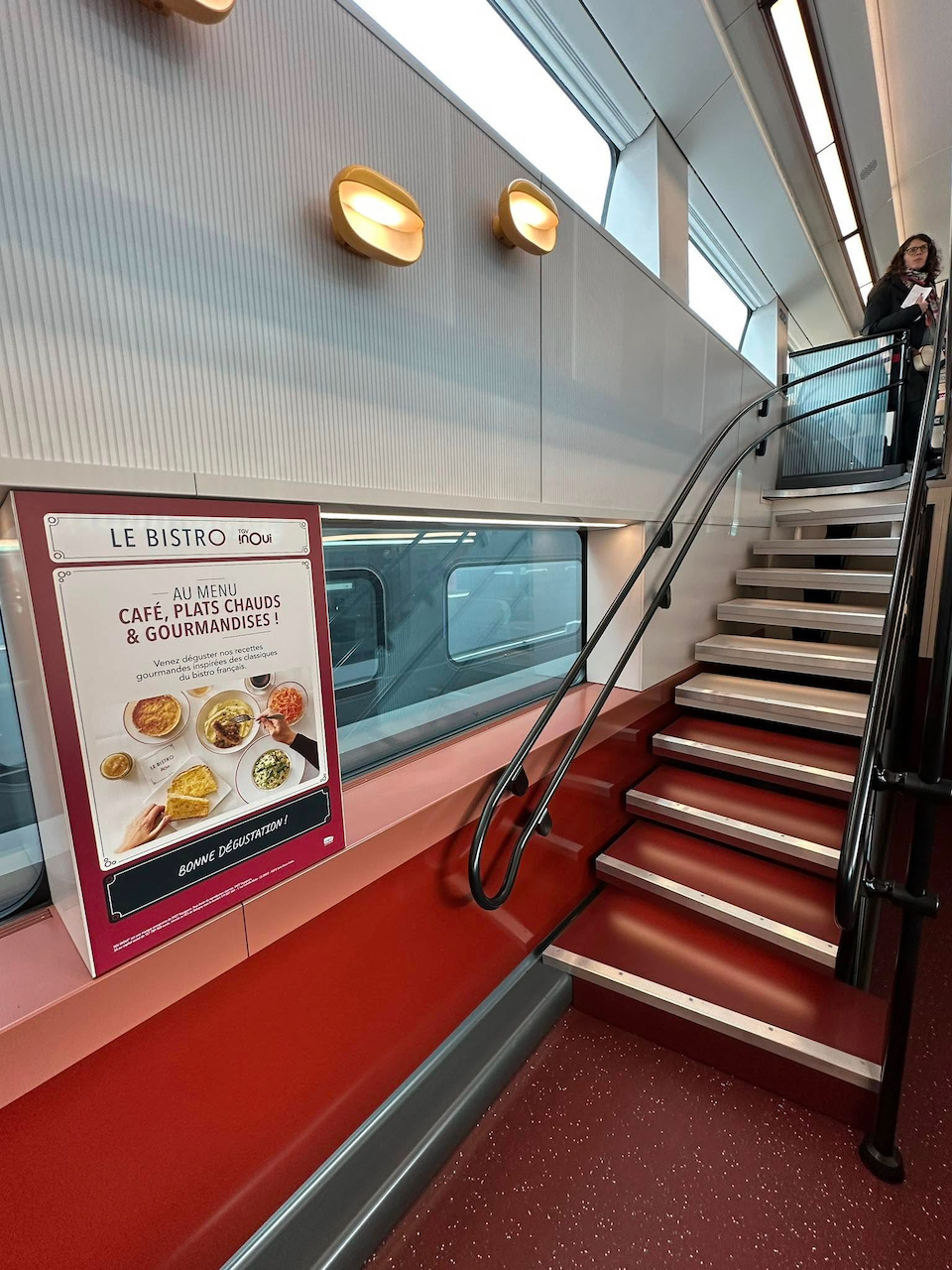
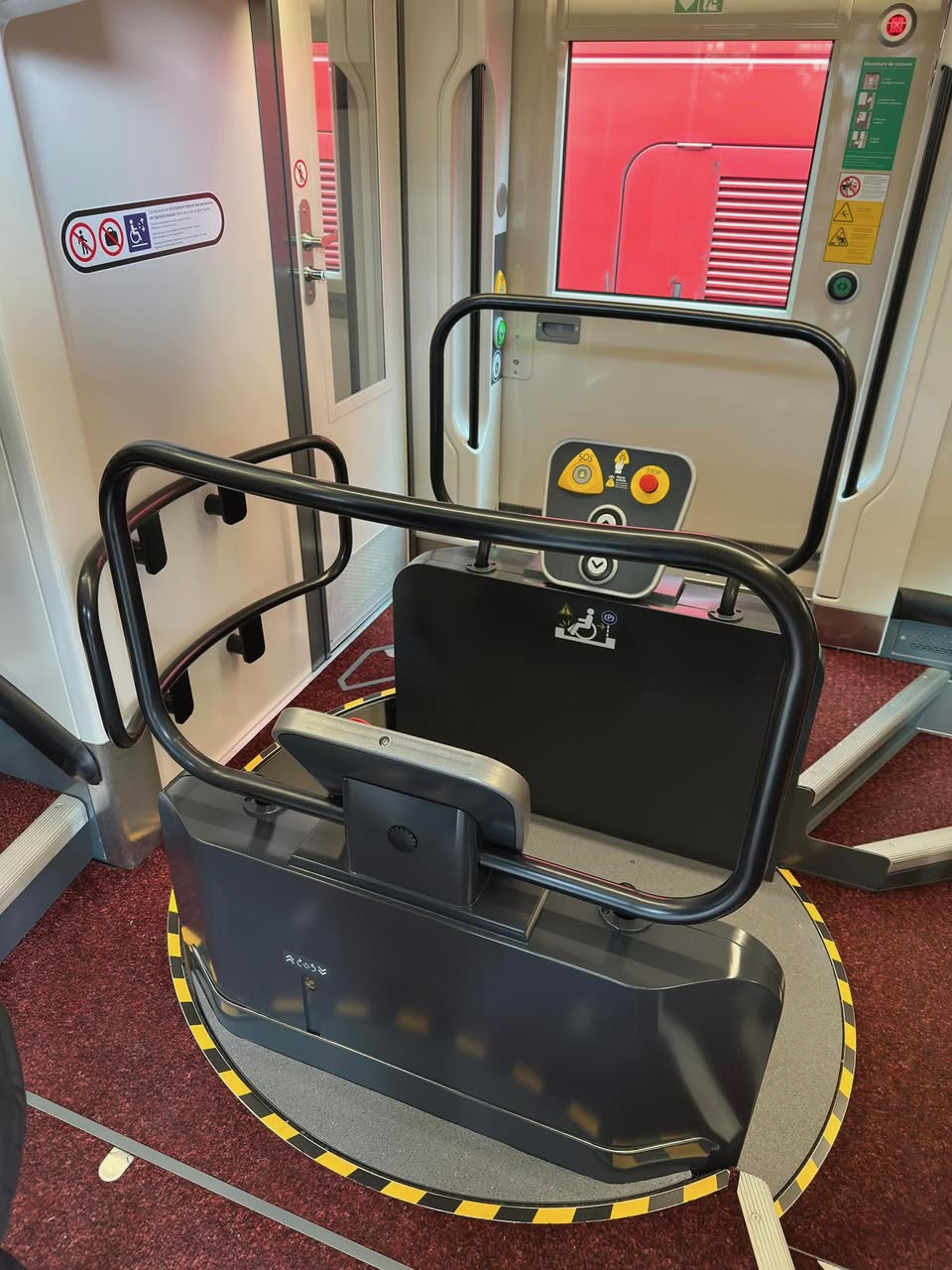
The PMR-accessible coach has a platform-level entrance and a ‘turntable’ which allows a wheelchair to be turned and lowered to the level of the lower saloon. This is a laudable feature but looks like it will block access for other passengers during boarding and alighting and may require staff intervention despite SNCF’s claim that wheelchair-users will be able to reach their places unassisted. The turntable leads into the lower deck where there are five spaces for wheelchairs, three with anchors and two where the user can transfer to a seat, together with six seats for accompanying passengers; there is also an accessible toilet. The upper level is given over to second-class passengers and includes a compartment for on-board staff (two seats) with equipment for making announcements.
Refreshments will be available in a completely redesigned Bistro car. In first and second generation Duplex sets, the ‘buffet’ is located on the upper deck, with electrical components occupying the whole of the lower level. In TGV M, this equipment has been reduced in size and relocated throughout the train. Rather than fill the space freed up with more seats (although this can be done in a high-density version), both levels are given over to the bistro. The 28 (somewhat rudimentary) seats are upstairs and a wide staircase leads down to the serving area.
This contains a set of large, cooled display cabinets for food and drink, a counter, two self-service tills and a rather restricted area with two microwaves and two hot drinks machines. A barista will oversee people helping themselves to food, warming dishes and dispensing warm drinks themselves, then paying, probably only with bank cards. It remains to be seen how this will work when the vehicle is crowded, and how theft of food can be avoided. Menus will change three times a year, with bistro classics such as Toulouse sausages replacing dishes created by well-known chefs.
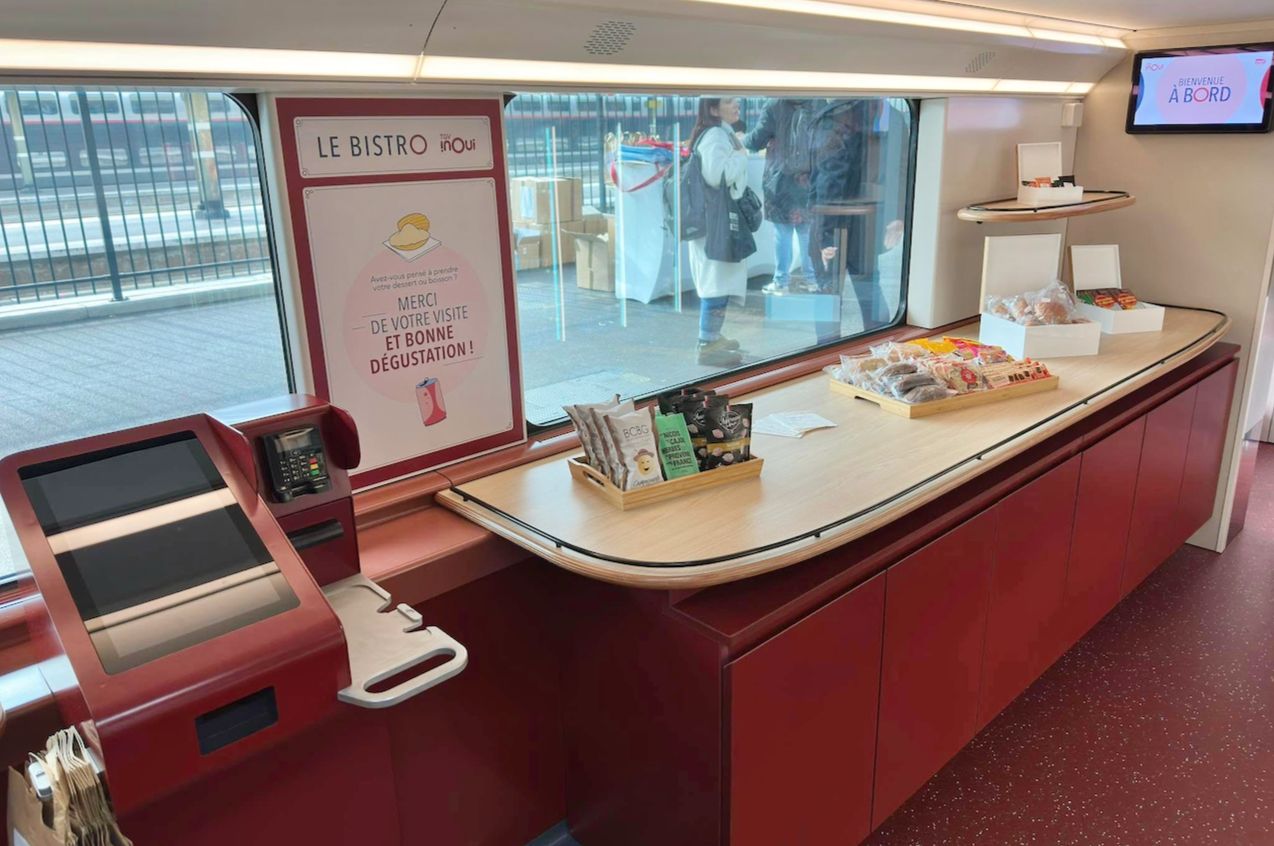
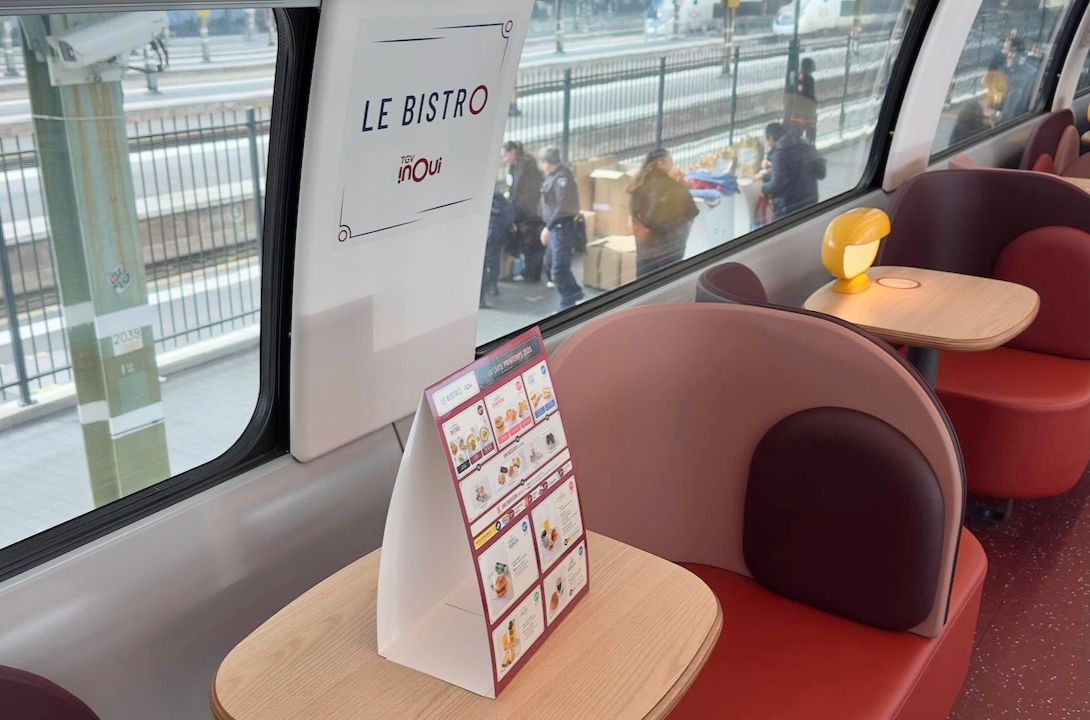
Throughout the train, seat numbering has been simplified. At present coaches have the same range of seat numbers so someone entering the wrong coach could easily occupy the wrong seat (a frequent occurrence). Now, seat numbers in coach 1 will be in the 100s, coach 2 the 200s and so on. Numbers rise from the entrance inwards and upwards.
SNCF and Alstom made much of the 400-plus technical innovations incorporated into the train’s design, number one being the greffon (transplant) lithium-ion back-up battery power supply which will allow trains to keep running for about 10km to an accessible stopping place (a station or loop) in the event of interruption to the traction power, rather than being marooned in open country.
Five sets are currently on test. Last month, we reported that the first would run in June 2026 between Paris and Marseille following a further six-month delay. However, on 11 March SNCF Voyageurs PDG Christophe Fanichet maintained that they would enter service “from the beginning of 2026”
All photos: Christophe Masse.
The Last Poste
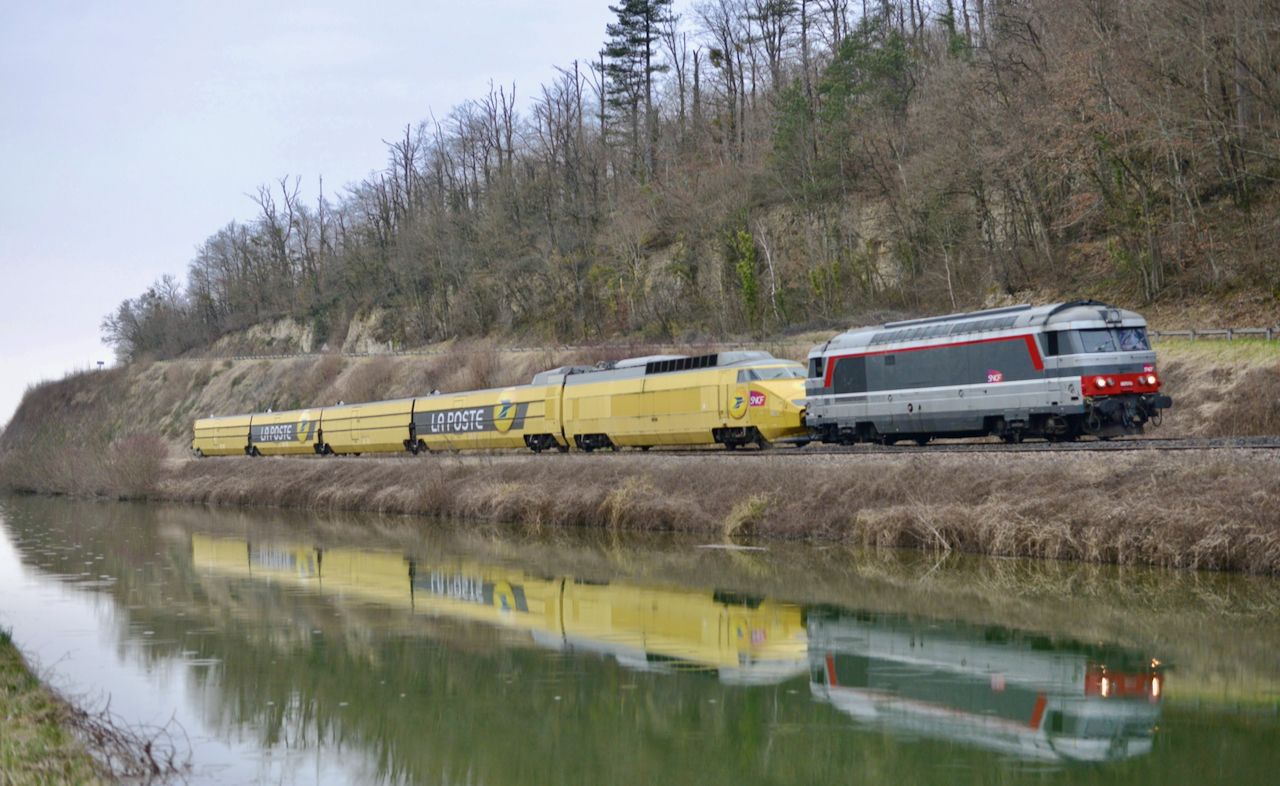
The day after the latest TGV was presented to the press the last of a previous era was heading to be broken up. On 12 March the last half set of the TGV Poste (954), that has been in store since 2015, was towed from Villeneuve-St-Georges to Chalindrey. Seen above passing alongside the Marne-Saône Canal at Eurville-Bienville south of Saint Dizier, hauled by BB 67558. Photo: Jean-Louis Poggi.
Argenteuil Technicentre officially opens
Transilien Line J’s expanded technicentre at Argenteuil, known as Val Notre Dame, was officially opened on 19 February. It is the main base for the 99 seven-car Z 50000 EMUs operating Paris Saint-Lazare – Gisors/Vernon-Giverny/Ermont-Eaubonne services, carrying 260,000 passengers a day. Operational since last November, the €200 million extension comprises 5,000m2 with four new buildings where Level 2 and 3 maintenance is carried out. The largest extends over 3,200m2 with three tracks; inspection pits and raised platforms allow full access to underfloor and roof-mounted equipment. There is also a wheel lathe.
Île-de-France Mobilités describes it as the first technicentre to be designed by an alliance of architects, construction management and construction companies, a process which ensured completion on-time and within budget. A sound ecological footprint is achieved by 120m2 of photovoltaic panels to supply hot water; 1,000m2 of green roof; recovery of rainwater for cleaning purposes; and reinforced thermal insulation and economical lighting. It is the first technicentre to receive the E3C1 certificate for energy and environmental performance. Photos below: SNCF Voyageurs.
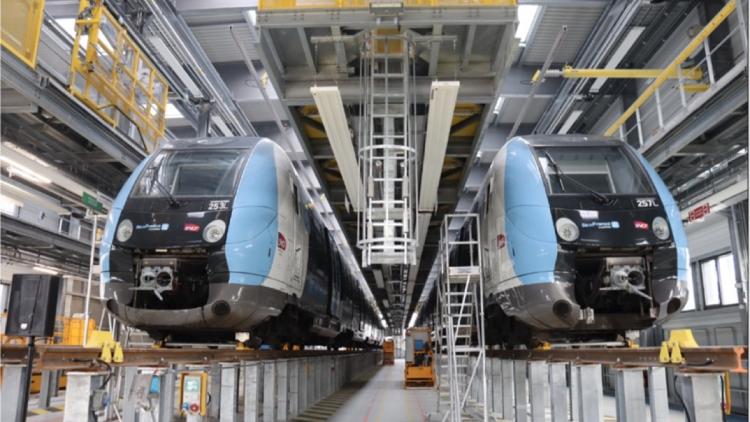
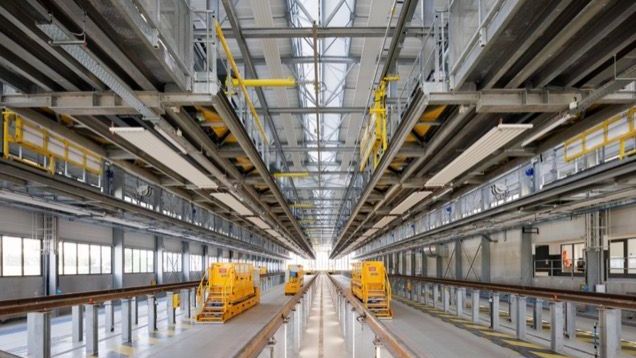
Clermont-Ferrand. Construction started in January of the new technicentre at Le Brézet maintenance depot and modernisation of existing buildings and equipment. AURA is investing €52.3 million to provide additional facilities for the région’s rolling stock and expanded capacity for Clermont’s developing SERM network. It will take over some minor work currently carried out whilst trains layover in Clermont station and also at Aurillac. When fully operational, the extended depot will be home to 62 X73500 single cars, 12 Régiolis B 84500 MUs and the three hydrogen-powered MUs on order, for which refuelling facilities are to be built. Provision of a wheel lathe will reduce empty-stock movements to Lyon-Vaise depot for profiling. The new facilities will be commissioned in early 2027. AURA is spending a total of €170 million on its maintenance depots: €100 million at Saint-Étienne, €11 million at Saint-Gervais, and €10 million at Vénissieux to provide additional storage tracks for Regio 2N trains (completed last summer).

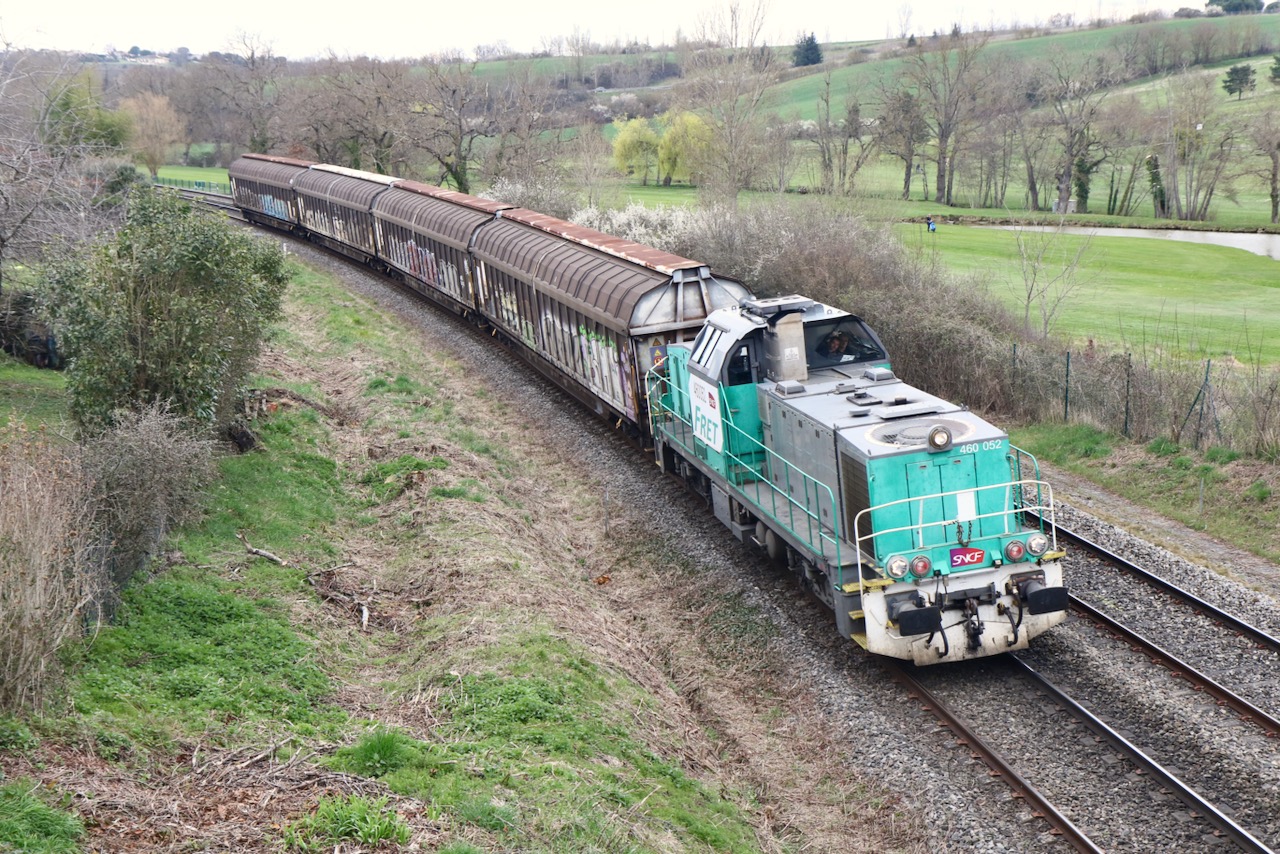
A test run for a potential new flow for Hexafret between Viviez-Decazeville and Douai took place on 13 March, when BB 60052 ran from Saint Jory to Viviez-Decazeville with four loaded wagons from Douai. It returned the following day as Train 434833 Viviez-Decazeville – Saint-Jory. It is seen above having just joined the bi-directional double track section approaching Montrabé, It is travelling on the right hand track in readiness for the chord that will give the direct route to Saint-Jory Yard. Apart from the ill-fated Railcoop workings between November 2021 and April 2023, this is the first freight for many years over this section. If considered successful a weekly return service of eight wagons could be introduced at the end of the year. Photo: Georges Turpin.
Solid financial results for SNCF Groupe
In its 2024 annual results SNCF Groupe reported a net profit of €1.6 bn compared to €1.3 bn in 2023. Turnover for the year was €43 bn, a 4.8% increase on 2023's €41.8 bn. Gross profit or EBITDA (Earnings before Interest, Taxes, Depreciation, and Amortisation) was up by 8% from €6.4 to €7bn. Debt increased slightly from €24.2 to €24.8 bn, although this was seen as an improvement when viewed against the increased turnover and EBITDA. 90% of debt is on long-term fixed rate loans with an average length of 12.6 years and at interest rates 2% below current market levels. The €1.7 bn paid to the State in interest payments has been returned for investment in the rail network.
Of the €43.4 bn turnover, 43% was generated by the two 'arms length' undertakings, international logistics company Geodis (26%) and public transport operator Keolis (17%), which between them generated 26% of EBITDA. Keolis has operations on every continent. Geodis and Keolis have 73,000 employees outside France, with 33% of turnover and 22% of EBITDA coming from overseas operations.
Investment during 2024 was €10.8 bn, a slight increase on the previous year, with 95% taking place in France. The main areas were:
● SNCF Réseau with €3.1 bn in network upgrades (track, signalling, bridges, engineering structures) and €1.9 bn on new developments (Eole, CDG Express, Euralpin Lyon-Turin);
● TGV Intercités, €0.9 bn on rolling stock refurbishment;
● Transilien, €1.3 bn on new rolling stock;
● TER, €1.3 bn on rolling stock refurbishment;
● SNCF Gares & Connexions, €1 bn mainly on improvements for the Olympics and developments at Porte Maillot, La Défense and Nanterre-la-Folie;
● Keolis/Geodis, €.4bn.
These figures include funding from the state and the régions in addition to that provided from within the groupe.
Passenger operations by SNCF Voyageurs saw revenue increase by 5.3% with increased passenger volumes across all areas: TGV 4%, TER 10.2% and Transilien 8%. Despite this, EBITDA was down by 3.3% mainly due to increased track access charges by SNCF Réseau not being fully passed on in ticket prices.
On the freight side, Rail Logistics Europe saw turnover increase by nearly 8% to €1.8 bn, although this formed only 3.5% of Groupe turnover. Nevertheless with EBITDA at 11.4%, this was seen as a particularly successful performance as some of the most profitable freight flows were handed over to competitors under the economic discontinuance of Fret SNCF and creation of Hexafret and Technis. A particular area of growth was movement of petroleum products.
The major successes of 2024 were smooth operation of the Paris Olympics, with an additional 6,000 staff employed to assist the 500,000 daily spectators; commissioning of RER E (Eole) extension to the west of Paris which marks a major step in development of sustainable mobility in the Paris region; introduction of ERTMS on the Paris – Lyon LGV that will enable a 25% increase in traffic by 2030, and the creation of Hexafret and Technis, subsidiaries of Rail Logistics Europe, which succeeded Fret SNCF in early 2025.
On corporate sustainability, the Groupe has pursued its two main themes of reduction of its environmental footprint (decarbonisation, circular economy, biodiversity) with greenhouse gasses reduced by 15.1% during the year, and having a positive impact on society and in the régions. During the year, 97% of goods and services were purchased from French companies, and 27,700 staff recruited of whom 18,500 were on permanent contracts and 23% women; there are also 10,000 trainees.
Getlink on target. Channel Tunnel operator Getlink reported end-of-year results as expected with EBITDA of €833 million on turnover of €1,614 million, and a net profit of €317 million. Turnover was down 12% due to normalisation of electricity prices and suspension in the last quarter of ElecLink, the 1,000MW cable linking Britain and France, due to a weakness in the cable support structure. Eurotunnel's revenue increased 3% to €1,166 million with EBITDA of €642 million, while freight operator Europorte saw revenue increase by 12% to €168 million, delivering EBITDA of €32 million.
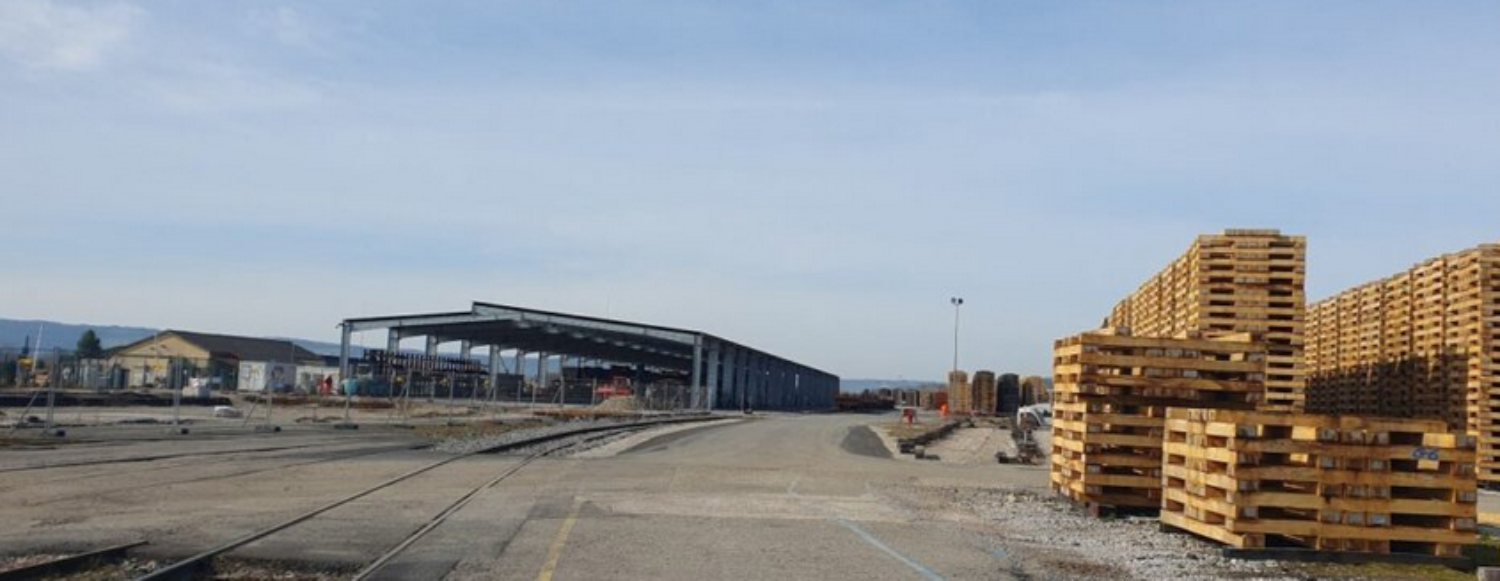
No more creosote
An example of the SNCF corporate objective to reduce its environmental footprint is the modernisation of its timber-sleeper plant at Bretenoux on the Brive – Aurillac line that will cease using creosote as a preservative in line with the EU ban on the chemical from 2029. The foundation stone of a new plant costing €6 million was laid on 17 February. When commissioned in a year’s time, production will change to copper-oil treatment of sleepers, a more-expensive process but one which uses less energy and is much safer than dangerous and polluting creosote.
Bretenoux is SNCF’s only timber-sleeper production site, turning out 400,000 annually cut from locally-sourced oak. They are used primarily in yards and on bridges. Currently, they are creosote-treated in ancient autoclaves which came from Germany as war-reparations; from next year, production will be fully automated. The new process was developed from techniques used in agriculture and horticulture, the copper oil having natural fungicidal and anti-bacteria properties. Photo: actuLot.
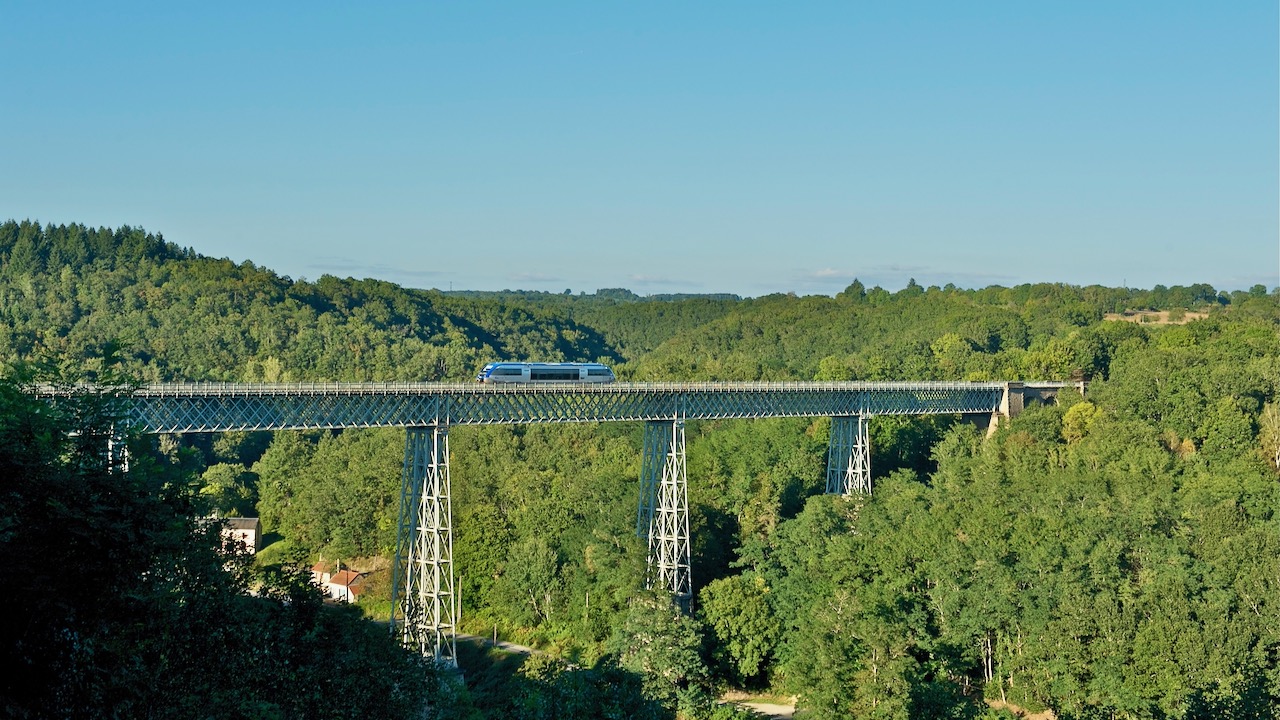
With the closure of the Felletin branch likely in August, only the two daily return services between LImoges and Montluçon will cross the Creuse viaduct at Busseau. Above. The 17.11 Limoges Benedictins – Felletin is seen crossing the viaduct on the evening of 12 September 2014. This is a double home turn for the Limoges crew who will spend the night in the little hotel near Felletin station and return early the next morning.
Closure news
Bourgogne-Franche-Comté. Following the région’s call on the State to renegotiate the cost-sharing formula under which rural railways are financed (see February News), L’Inspection générale de l'environnement et du développement durable (IGEDD), the government’s advisory body on transport and environmental issues, has been commissioned to review the prospects for BFC’s rural lines and estimate their future investment needs. It is expected to report in June.
Apart from the Morvan lines highlighted in February News, the Haute-Saône public services vigilance committee has already identified several others at risk of closure due to lack of funding for remedial work becoming urgent after the recent extreme weather. The Ligne des Hirondelles between Andelot and Saint-Claude, with 36 tunnels and 18 viaducts, is costly to maintain and operate, as is the Ligne des Horlogers from Besançon to Le Locle and La Chaux-de-Fonds in Switzerland. The former will shortly require €5 million-worth of work to avoid imposition of speed restrictions, and then heavy investment if trains are to continue running beyond 2027. The latter, though upgraded last year at a cost of €56 million and said to be ‘fit for the next 20 years’, is nevertheless particularly vulnerable to landslips and washouts. Frasne – Pontarlier falls into the same category.
The 76km Lure – Épinal line, whose stations attract 35,000 passengers annually, saw its service halved to four A/R daily in 2018. Remedial work was carried out in 2021 and 2023, when the 15km of single track between Luxeuil-les-Bains and Aillevillers was upgraded at a cost of €1.9 million. Much of the remainder is in a degraded state and further work is planned during a two-month closure over the summer holidays at a cost of €5 million. SNCF Réseau estimates that expenditure of €90 million will be required after 2028. The state of the infrastructure is “most worrying” according to Catherine Faucogney who heads the vigilance committee: “Over the next two years, we are likely to see speed limits imposed, which could endanger the line’s sustainability.”
Routes radiating from Paray-le-Monial were also mentioned in the committee’s report. This station saw a 25% drop in traffic in 2023 following post-covid recovery. While the Paray – Montchanin – (Dijon) line has a well-used hourly peak service (two-hourly off-peak), the Moulins – Paray – Lyon transversal sees only four trains daily. The degraded 30km of double track between Paray-le-Monial and Gilly-sur-Loire is causing concern, with closure likely by 2027 if remedial work is not carried out.
Oyonnax. A good example of the challenges and contradictions around maintenance of desserts fines is the line to Oyonnax, the southern portion of the Ligne des Hirondelles. This was severed between Saint-Claude and Oyonnax in 2017 due to the poor state of the infrastructure, leaving Oyonnax to be served by three A/R a day plus 10 buses to and from Bourg-en-Bresse. Closure of this 32km section, which straddles the boundary between Bourgogne-Franche-Comté and Auvergne-Rhône-Alpes, remains a bone of contention in these towns located at the extremity of their respective régions. Saint-Claude in BFC misses its outlet to Lyon and the south. Oyonnax in AURA has eight buses daily north to Saint-Claude, though typically these fail to connect with the four trains northwards to Dole.
Trains resumed running to Oyonnax on 28 March after a month’s engineering work between Brion-Montréal-la-Cluse and Martignat. While delighted in one sense, having feared for the future of their residual service, locals reacted badly to the high cost of the recent work, €5 million (91% financed by AURA) to renew just 600m of track. A further closure next year will see replacement of 3,500 sleepers, renovation of structures and renewal of foundations. So the line looks safe for the immediate future. But as with the Morvan lines, can such expenditure really be justified when most of the service is provided by bus?
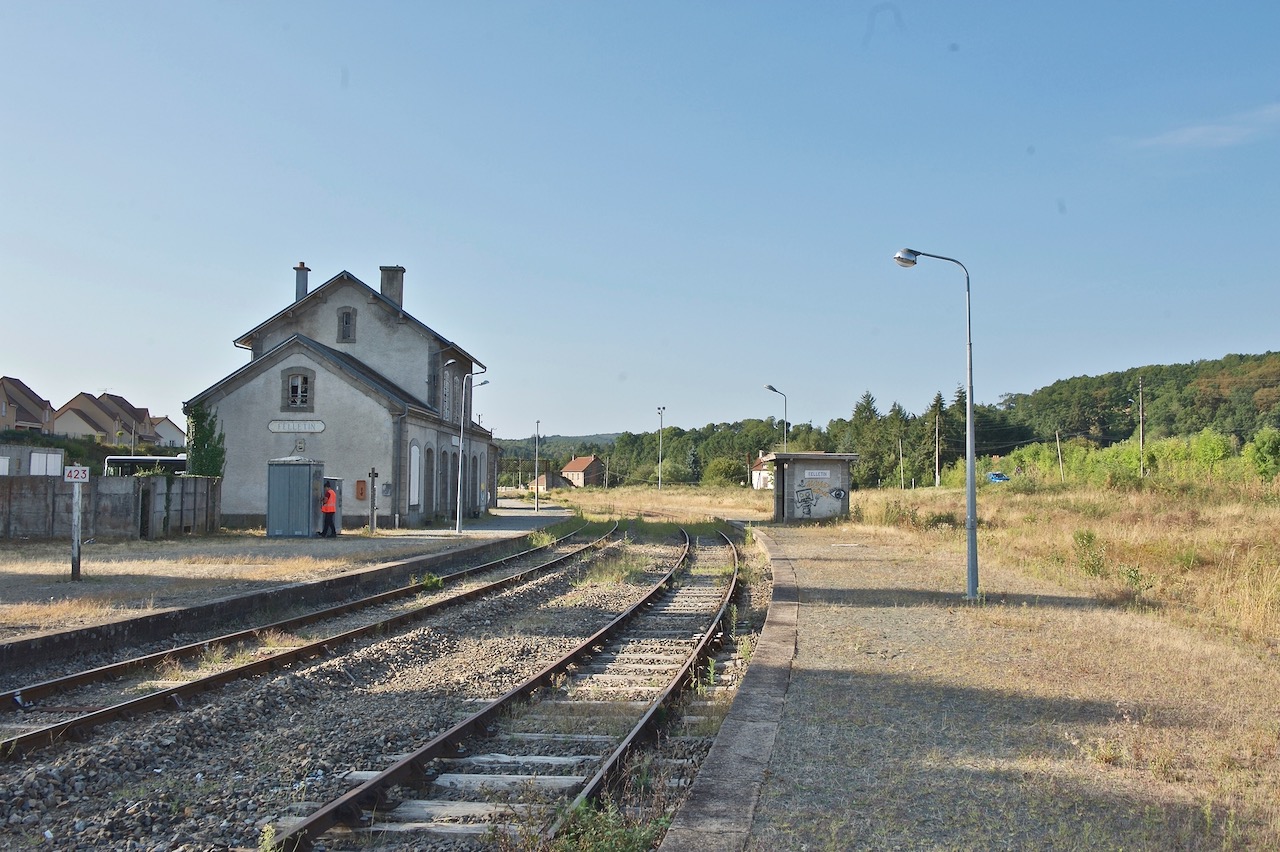
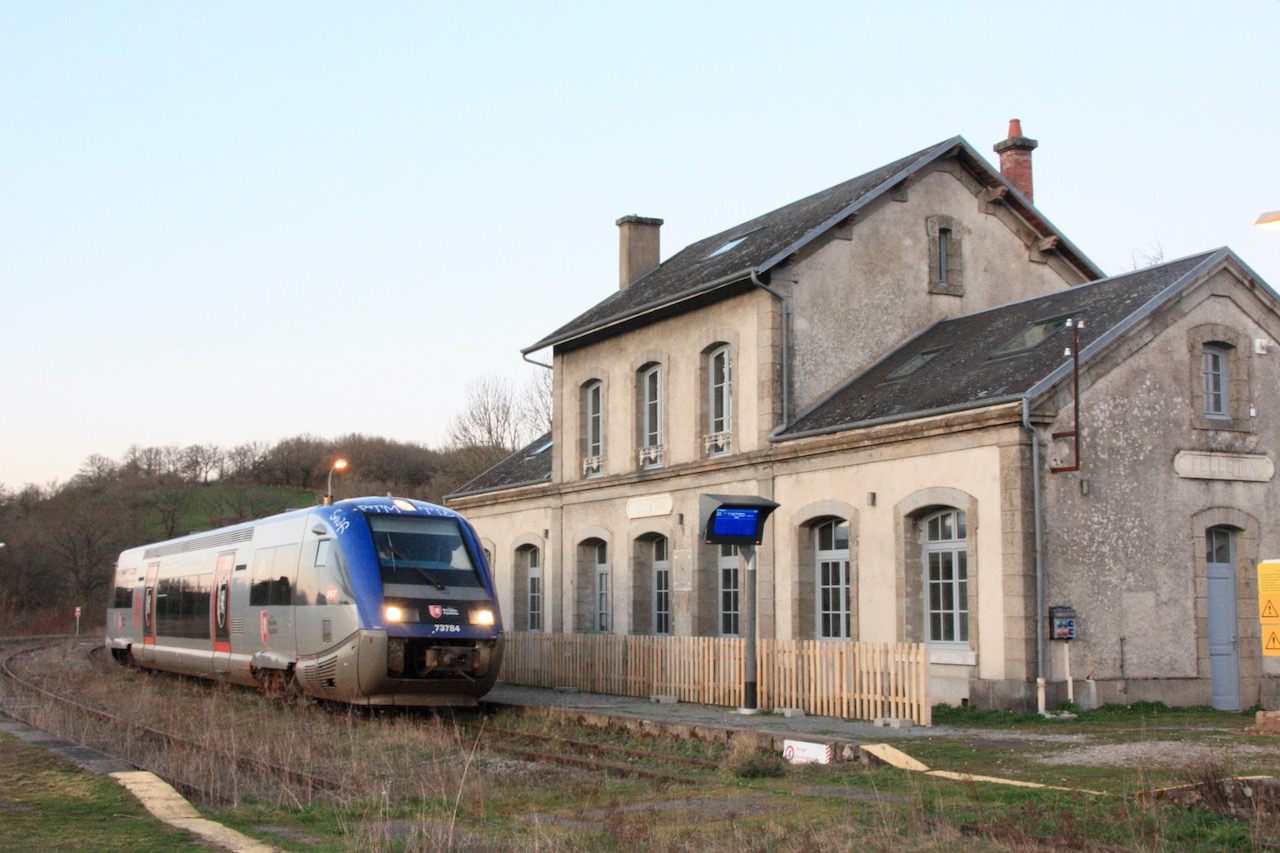
Above left. The layout at Felletin with a run around loop and stabling point for a single autorail just beyond the station building. The line once extended on to Ussel providing connections to Brive and Clermont-Ferrand, with the station boasting extensive sidings on the right hand side of the platforms. Right. Autorail X 73784 after arrival at Felletin on 24 March 2025 with the 17.10 service from Limoges. The electronic display on the platform is a recent addition. Photo: railwayworld.net/Gareth David.
Felletin. Opposition is growing to closure in August of the Busseau-sur-Creuse – Felletin line. On 1 March at midday 200 people protested at Guéret, delaying departure of TER 868720 11.10 Felletin – Limoges. Valérie Simonet, president of Creuse département, said that loss of the service would leave the population of a vast rural area far from any railway and scupper efforts to make the countryside more attractive to incomers and tourists. “There will be no TGV for us,” she said, so “we must hang on to our rural lines.”
Speakers pointed to closures in Nouvelle-Aquitaine during the past 10 years which were supposed to be ‘temporary’ whilst funding was sought for renewing worn-out track and structures. The région’s offer last month of €15 million towards reopening between Ussel and Volvic seemed at odds with its apparent inability to fund upgrading of the Felletin line. It was also pointed out that major expenditure would only be worthwhile if a decent service were to be provided, ie more than Felletin’s two or three per day at seemingly random times. Reporters visiting the line have found the trains mostly empty; on 21 March France Info encountered only two passengers on the 06.23 ex-Felletin, one of whom was the town's maire. Journalist Gareth David had a similar experience in the last week of March. His account of the trip can be seen here:
https://railwayworld.net/2025/03/28/death-of-a-french-branch-line/#more-208033
Angoulême – Limoges. Despite the recent pronouncement by Nouvelle-Aquitaine’s president that no money would be available for reopening, the région says ‘it has not abandoned the line’, closed as a through route in 2018. Charente département had offered €15 million towards the cost of reopening but is now unsure whether this can be afforded in the current financial climate.
Saumur – La Roche-sur-Yon. This straggling cross-country line is poorly served due to its situation running through Pays de la Loire and the northern tip of Nouvelle-Aquitaine régions. Thouars (population 14,000) is the most important of the three stations in NA, the 39km thence to Saumur having been electrified in the early 1980s. €8 million was spent last year renovating just 2km of track. Two trains to Saumur supplement the daily winter La Roche-sur-Yon – Saumur/Tours through service that runs MF only. Major upgrading work on the central section had been planned by SNCF Réseau for 2028, with €1.2 million allocated for short-term maintenance to avoid speed restrictions. Now locals fear that complete closure might be an option when so much of the service is provided by buses.
And some good news. Visiting Briançon on 28 February to inaugurate accessibility work at the station, president Renaud Muselier announced that the région would not close any line or station despite the current economic situation.
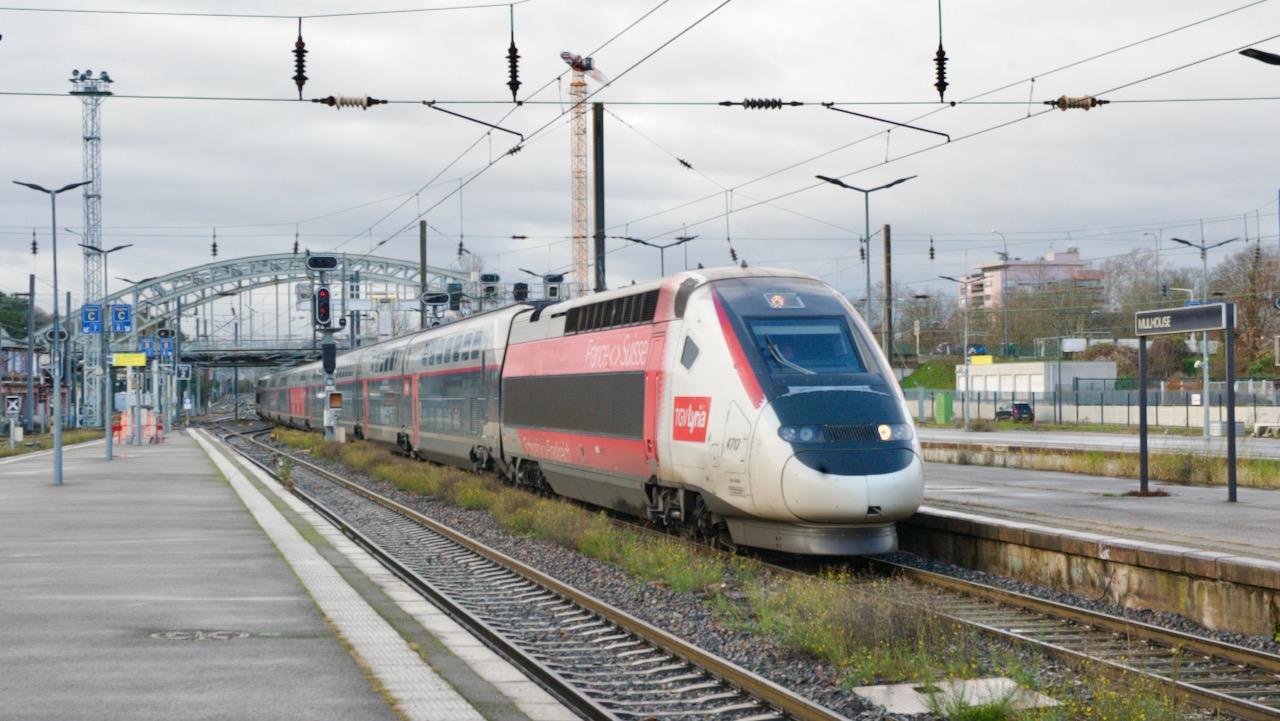
Euroduplex Set 4717 at Mulhouse on 5 December 2023 with Lyria 9203 07.22 Paris Gare de Lyon – Bâle and Zürich. These trains can run on 1.5kV, 15kV and 25kV.
SBB plans international expansion
Encouraged by growth in international travel, SBB is considering expansion of services to France and Italy, and possibly other destinations such as Barcelona and London, for which it would require up to new 40 trainsets. A call for information on multi-system high-speed trains was issued on 12 March. SBB is mulling two procurement options: acquisition of trains together with a 15-year maintenance agreement, or a 15-year operating lease. More information is to be shared with potential manufacturers and lessors before the summer, ahead of a possible call for tenders in 2026.
The proposed services would be run ‘in co-operation with partner railway companies’. SBB will also need to replace older trains in its existing international fleet in the medium term, hence the 40 trainsets. The new trains could be suitable for operation at 300 km/h or more in other countries, although there are no routes approved in Switzerland for such speeds.
Cross-border service to France is at present operated by the joint SBB/SNCF Lyria subsidiary, running from Lausanne/Genève and Zürich/Bâle to Paris, plus Genève – Marseille summer-only. Expanded service to French destinations might include year-round high-speed trains to southern France, continuing to Barcelona as well as the Côte d’Azur. SBB would also like to offer direct services to cities beyond Paris, including London. This would be ‘technically feasible but challenging’ it says, given the barriers facing new entrants to Channel Tunnel operations; such services are not considered likely until the 2030s.
● Extending and expanding capacity of the successful Léman Express network, including introduction of double-deck trains;
● Improving the Genève – Lyon TER offer and introduction of TGV services to destinations north of Paris and to Spain and Italy (as above);
● Construction of the proposed direct north-south light rail route into France.
AURA currently funds and operates TERs between the two cities running roughly two-hourly with four to six stops, last departure from Genève at 19.30 and Lyon at 20.38, best journey time 1h 52. Genève council has invited SBB to propose ‘a fast, direct offer with only one intermediate stop’ (at Bellegarde/Valserhône), running every two hours in addition to the AURA service. However, technical and administrative differences would prevent early action. For a start, SBB (electrified at 15kV) has no suitable 1.5/25kV rolling stock; trains to Lyon must switch from 25kV to 1.5kV at Bellegarde.
SBB, SNCF and AURA are reportedly discussing what improvements could be achieved without major investment, including provision of hourly trains and extending service to 23.00 daily. Genève would like to see trains serving Lyon’s Saint-Exupéry airport but this would not be possible until the Lyon freight bypass is built (see March News).
Troyes electrification
Two weekends in March saw demolition of overbridges at Saint-Lyé and Savières, starting Phase 2 of the Paris – Troyes electrification, the 56km between Nogent-sur-Seine and Troyes (Grand Est Line 4). Out of 30 structures, only four have sufficient headroom for OHE; the remaining 26 are to be rebuilt or removed entirely.
Preparatory work has been going on since commissioning in November of the service depot at Romilly-sur-Seine where a 24,000m2 storage area has been laid out with three sidings off the main line. When fully operational in June, 80 personnel will be based here. The €140 million cost is financed by the State, Grand Est région and nine départements and communes.
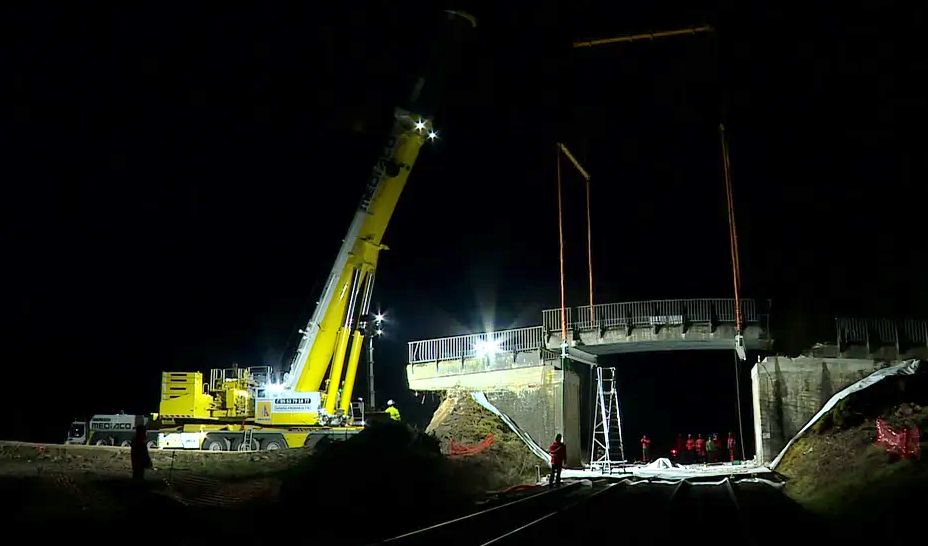
Electrification at 25kV 50Hz from the Paris outskirts at Gretz-Armainvilliers (RER Line E) to Troyes, plus the short branch from Longueville to Provins, was originally approved in 2016 for completion in two phases by 2022, but in the event wires had only reached Nogent-sur-Seine by that year. In Phase 2, a total of 119 track-km is being electrified, comprising 108km of running line and 11km of layby and sidings mainly at Troyes; 2,300 masts and other OHE structures will be erected. One new substation is required, located at Saint-Mesmin. Changes to the signalling and its immunisation will see replacement of 150km of cable. The KVB (vitesse par balises) train-control system is to be installed, along with video surveillance of major structures for rapid trouble-shooting.
Apart from several weekend possessions, most of the work will be done at night and during two months’ closure over the summer holidays, gradually ramping up to the start of full-scale installation in November. Completion is scheduled for late 2028 when Paris – Troyes trains will be accelerated by 10min. Troyes is currently served roughly hourly from Paris Est by Grand Est Coradia Liner bimode MUs, extended twice daily to Dijon and five a day to Belfort, of which three continue to Mulhouse. There is also a curious vestige of past through trains to Vosges spa resorts, a Fridays-only seasonal extension from Culmont-Chalindrey to Contrexéville and Vittel of TER 836407 15.13 Paris Est via Troyes, returning on Sundays at 16.21; this is the only passenger service at these two stations. The 2025 season started on 28 March. Photo: © France Télévisions/JB.
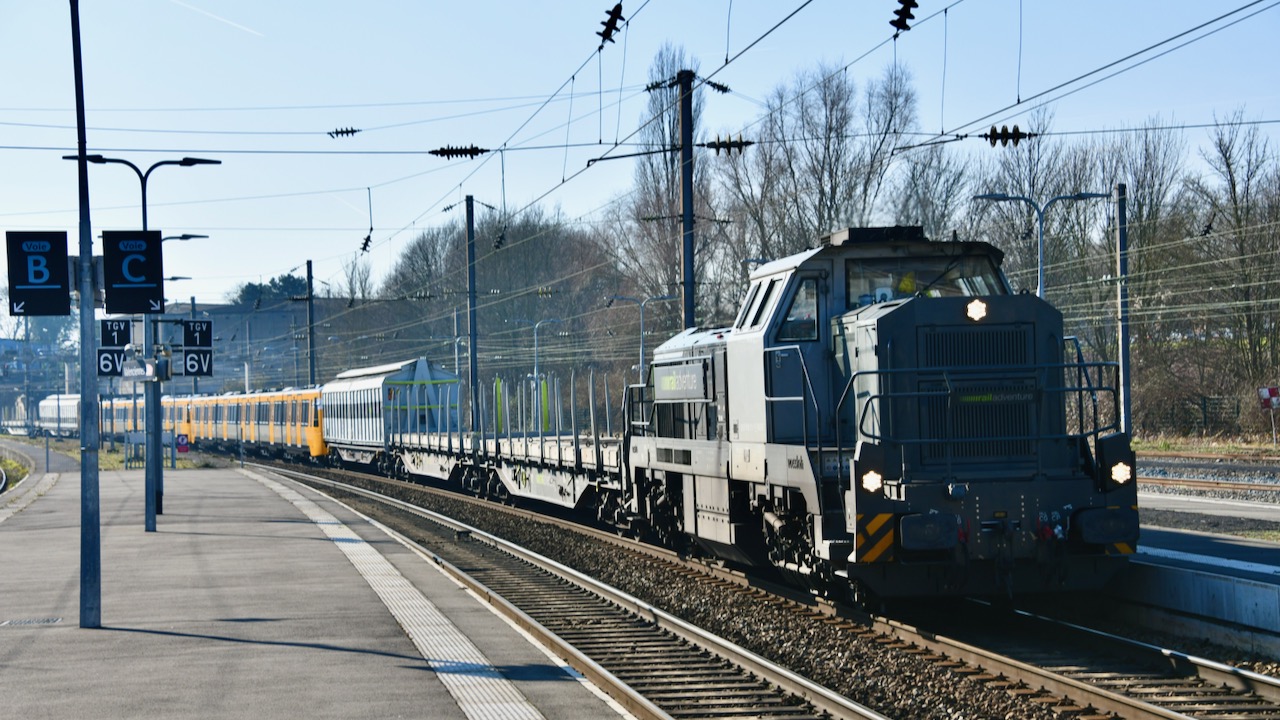
Stock movements
RailAdventure’s Vossloh DE18 4185.011 is seen above passing through Valenciennes on 17 February with new Tyne & Wear Metro Stadler units Nos 555 009/008 en route from Saint Margrethen, Switzerland, to Gosforth, operating at this stage as 42880 Forbach – Calais. The following day, NPdC-liveried VR2N set N07, heavily covered in graffiti, is seen below at the start of its final journey, passing Wavrin as 764783 Lille – Sotteville hauled by BB 67593/67406. Photos: Didier Delattre.
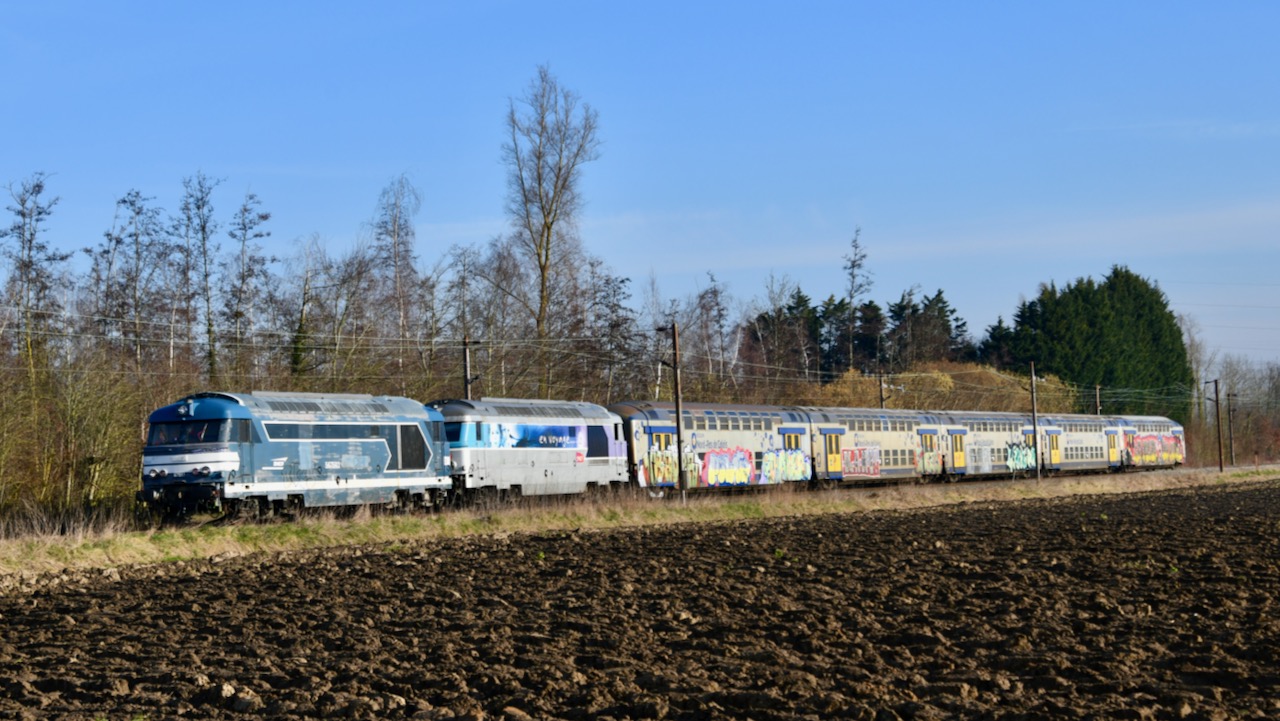
News in brief
Transport resilience. Meeting in Warsaw on 17/18 March, European transport ministers discussed the need for greater resilience of transport networks in the face of current geopolitical threats. ‘There can be no safe and strong Europe without a transport system resilient to threats’, they concluded. It was agreed that development of dual-use infrastructure, serving both civilian and military purposes, is essential. Railway works to achieve this could include strengthening of bridges and enlarging tunnels to accommodate military traffic, and provision of capacity to move troops when required at short notice. In France this might encompass revitalisation of parts of the ‘strategic network’ currently mothballed. The need for greater vigilance in protecting signalling, communications and data installations from cyber attacks was also covered. France recorded a 15% rise in such attacks in 2024 as well as many acts of sabotage like those which crippled the rail network on the first day of the Olympic Games. France’s military rail activity has increased since the start of the war in 2022, in particular to support the rapid response force based in Romania and for delivery of equipment and fuel to Ukraine.
Maurienne reopening. The Maurienne Valley line linking Lyon and Turin finally reopened on the 31 March. It has taken 19 months to stabilise the cliffs and repair the line since the landslide at La Praz, near Modane, on the 27 August 2023. SNCF services started on the 31 March with Trenitalia services on the 1 April. Passenger volumes are expected to return to normal levels fairly quickly, but freight levels are more problematic. Prior to the landslide freight traffic had fallen to 3 million tonnes a year due to the constraints of the line, particularly height constraints through the 13.7 km Frejus Tunnel. During the closure customers have reorganised their supply chains, moving to road transport or alternative routes, and it is likely to be difficult to win this traffic back.
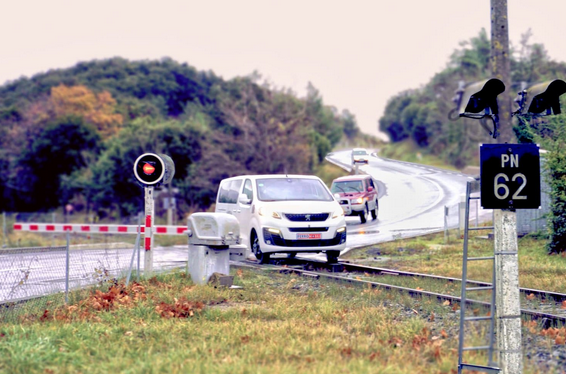
Ferromobile trials. One the innovative vehicles being developed to revive moribund railways is to be trialled on the 37km Courpière – Ambert section of the Livradois-Forez Railway in Auvergne. The road-rail Ferromobile adds a patented system of retractable railway wheels to a mass-produced Peugeot E-Traveller, in its designers’ words ‘combining the best aspects of road and rail technology’ for lightweight economical operation on rural lines. It is battery-powered and fully-automated in the rail mode; there are seats for eight passengers. Test running will take place at the end of the Livradois-Forez 2025 operating season. Several level crossings are being renovated as part of the agreement. Photo: Ferromobile.
Nova 14. The concessionaire for Grand Est’s €150 million Nancy – Contrexéville reopening published its Déclaration d’intention at the end of January, a legal instrument setting out the principal characteristics of the project in advance of public consultation taking place during March and April. It envisages carrying 550,000 passengers in the first year of operation and a Contrexéville – Paris journey time of 2h 55. Preliminary work has begun and reconstruction of the line is expected to start in September.
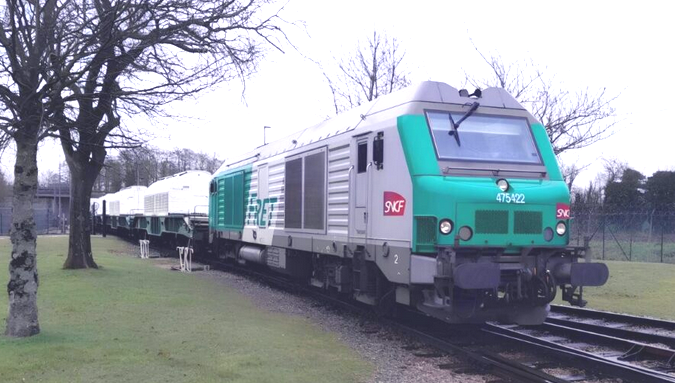
Nuclear waste. A shipment from the Netherlands arrived at the Orano plant in Normandie on 26 February, the first since 2022, under a long-standing contract for processing 216tonnes of spent fuel from the Borssele power station. Once processed and recycled, the remaining 4% waste will be returned to the Netherlands for storage. BB 75422 arrives with nuclear flasks at Armanville, south of Cherbourg. Photo: Orano.
SERM news. Toulouse launched the initial phase of its SERM plan on 3 March, with a grant of €535,000 towards development of financing and governance parameters. At Chambéry, €1.5 million funding for initial studies was approved on 10 March, while the Nantes SERM steering group met on 26 February to consider improvements to the service to Saint-Nazaire, and announced two additional A/R for the Nantes – Pornic/Saint-Gilles-Croix-de-Vie lines from December.
Au secours! Reporting on its efforts to improve reliability of the Paris – Clermont-Ferrand route, SNCF Voyageurs said that the rescue locomotive stationed at Nevers since March 2024 was called upon 17 times in its first year, helping to cut delay in 80% of incidents. The loco runs light every evening between Nevers and Montargis so as to be close at hand in case of breakdown affecting the last trains of the day, with two drivers rostered between 16.00 and 24.00. Unfortunately, the reserve loco is itself not immune to breakdown, having failed at Montargis on 1 March whilst assisting IC 5983 18.57 Paris Bercy to Clermont.
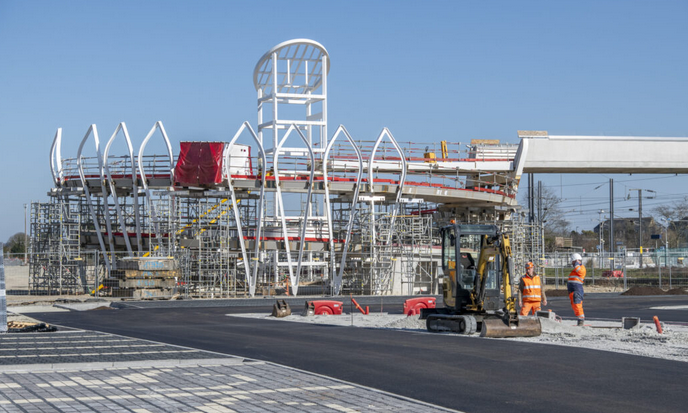
Vannes. The striking new accessible footbridge is taking shape with the cycle ramps installed and the 36 metallic ‘petals’ on each rotunda which will support the exterior cladding to be completed this month. Photo: Vannes Agglomération.
Louviers – Évreux. While trains will run again from Val-de-Reuil to Louviers as part of Rouen’s SERM project (see April 2024 News), the line southwards to Évreux, closed as a through route in 1940, is not to be reopened on account of the “staggering cost” according to Normandie région president Hervé Morin.
Channel Tunnel. ‘Virgin is not committed to launching a service just yet’ but is seeking partners to invest in its proposed high-speed operations through the Channel Tunnel. According to The Financial Times, the Virgin group is seeking to raise £300 million in equity and £400 million debt.
Monaco. Record patronage was recorded in 2024 with 9 million passengers using Monaco gare, where improvements are being made to ease overcrowding. The 15min interval service to Nice is settling down though there are grumbles about increased journey time now that all trains serve all stations, and the eight peak-hour services diagrammed for eight cars do not always run. In the longer term, the principality supports PACA’s plan to move to a 10min service, while it also hopes that through TGVs from Paris can be restored.
Millas. A second trial confirmed culpability of the driver of the bus in which six students were killed when it collided with a train on the level crossing here in December 2017. She was sentenced to five years’ imprisonment with two years suspended. The accident led SNCF to improve protection and safety, and to step up closure of dangerous crossings. In Occitanie for example, 54 out of 1,600 crossings are slated for closure or replacement this year.
Épernay. The former locomotive workshops, closed in 2015 and being redeveloped as part of the Berges de Marne business/residential quartier, is to house the headquarters of the Comité Champagne, the Champagne industry’s professional body. Two steam sheds are to be restored as offices, laboratories and cellars. Work starts in 2027.
Quiberon. Studies are underway for upgrading the Auray – Quiberon line (the Tire-Bouchon) following Bretagne’s grant of €3.3 million in December. Tender documents are being prepared for work to be carried out in time for the 2027 season. It is hoped that funding can be found for year-round service.
Service please. Studies are to be made into reopening Saint-Martin-Bellevue station between Annecy and La Roche-sur-Foron, closed since 2010 as the foot crossing is unsafe for passenger use. Léman Express trains run through every hour, stopping several times daily for passing purposes. An accessible footbridge would have to be built at a cost of €7 million. As at Le Teil in Ardèche (see March News), locals are frustrated by the sight of trains stopping without being able to take passengers. Journey time to Annecy would be 10min.
CFCL. Last year was difficult for the Chemin de fer de Charente Limousine, having to cope with a derailment and consequent repairs to the locomotive and track, plus the pressing need to renew the vélorails. For 2025, the communauté de communes de Charente Limousine has made a grant of €15,000 towards the salaries of the railway’s two permanent employees.
Dignified toilets. World Women’s Day on 8 March brought renewed efforts by female train crew for access to toilet facilities during their shifts. Despite a commitment by SNCF in 2022, no progress has been made with the suggestion that every 10-or-so stations on Paris suburban routes be equipped with suitable toilets, or that turnround times at terminals be lengthened to allow sufficient time for crew relief.
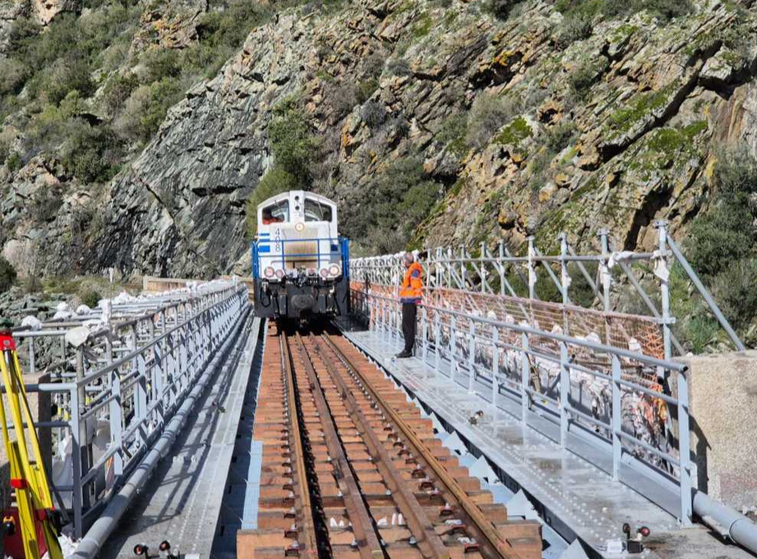
Corsica bridges. Passenger service resumed between Ponte Leccia and Casamozza on 17 March after four month’s closure for renovation of two bridges; load tests were carried out on the Muzelle bridge over the RT20 road on 13 March. Resignalling of the network is nearing completion with installations at 20 stations undergoing dynamic trials. The entire railway will be closed for two weeks over the Easter holidays for commissioning of the latest stage in the €38 million project. Photo: Corse Matin.
Wissembourg. Grand Est région announced on 13 March that a second maintenance depot to service the fleet of cross-border Régiolis EMUs would be built at Wissembourg by 2030.
Cholet. The long-running dispute between the commune and SNCF over responsibility for a footbridge has been resolved. The Nantes administrative court confirmed an earlier decision in favour of the commune. Now an agreement has been reached with SNCF for it to restore and strengthen the concrete structure which carries a public right-of-way across the platforms and adjacent tracks.
Les Herbiers. Pays de la Loire région is seeking bidders to assess the infrastructure of the (Cholet) – Saint-Christophe-des-Bois – Les Herbiers line, planned for reopening by 2030 to serve the Puy du Fou leisure park. Amongst the 23 bridges is the 300m long viaduc de Barbin, its 14 arches standing 38m high.
BreizhGO. A convention was signed on 17 March between Bretagne région and the five communautés des communes of Côtes-d’Armor département to finance 17 new weekday services under the BreizhGO Express Nord plan starting in September 2026. The extra trains, costing €4.3 million per year, will run on the Lannion – Plouaret-Trégor – Guingamp – Saint-Brieuc – Lamballe axis, together with some additional stops by existing services. Studies are to be made into provision of a passing loop at Kérauzern on the Plouaret – Lannion branch. This summer, the number of Paris TGVs serving Lannion is cut to one A/R daily.
Gemini Trains. Another putative challenger to Eurostar emerged on 24 March when Gemini Trains announced plans for up to five daily London – Paris/Brussels A/R services through the Channel Tunnel ‘starting in 2028’ and ‘aiming to change the face of European rail travel’. Headed by Lord Tony Berkeley, former Eurotunnel engineer and Rail Freight Group president, and former CAF France PDG Francis Nakache, Gemini has been working on its business plan for the past two years. It will seek funding for purchase of ‘new generation’ trains in the coming months.
Open access. According to a report in Catalonia’s leading newspaper La Vanguardia, Renfe is considering withdrawal from the French market due to long-standing difficulties in its relations with SNCF and repeated delays in certification of its Talgo S-106 trains. It is understood that these will not be cleared to run to Paris until 2029, meaning a five-year delay in launching Renfe’s Barcelona – Paris service. There’s also uncertainty about the proposed Barcelona – Toulouse service (see February News). Originally expected to start on 7 April tickets had still not gone on sale at the end of March.
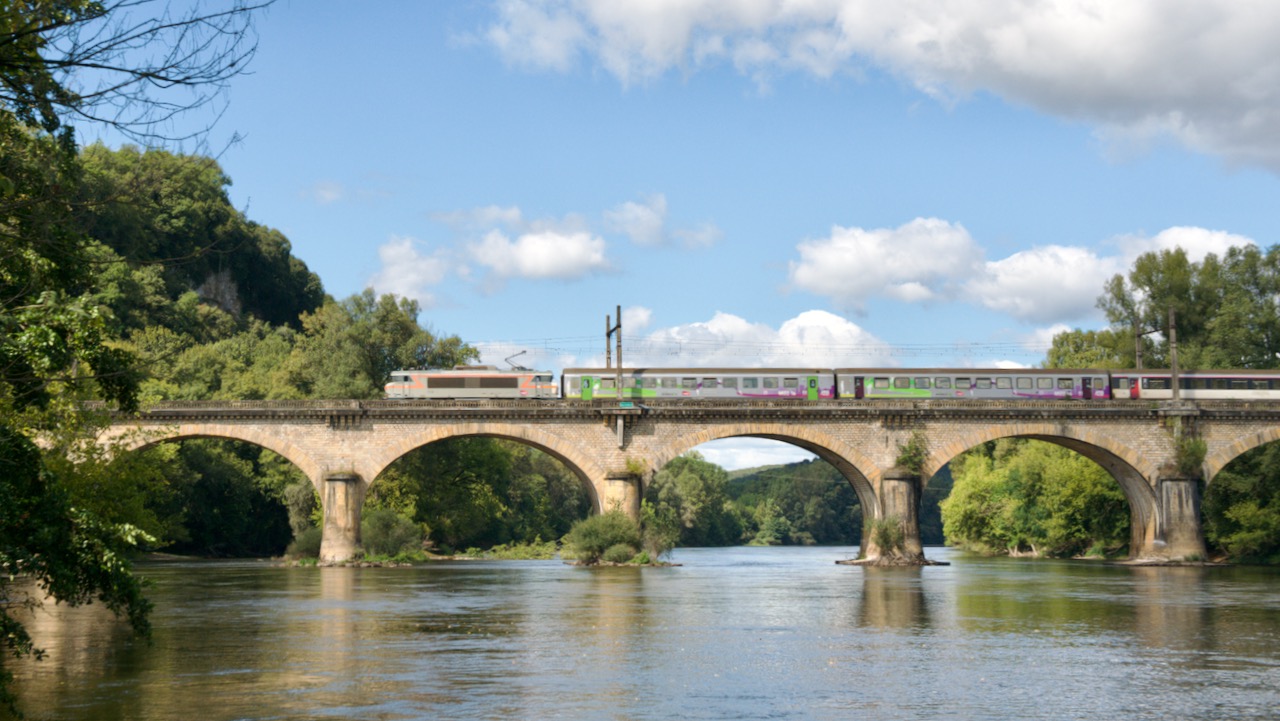
On 13 September 2024 BB 7255 crosses the Dordogne at Le Roc with IC 3619 08.28 Paris Austerlitz – Toulouse. Arriving at Les Aubrais at 09.30 this will be the last southbound train before the daytime engineering blockade between Paris and Les Aubrais begins during August. The next service from Paris will be the 17.13 Paris Austerlitz – Cahors after the blockade is lifted at 16.30. During the day passengers will be able to reach Cahors by travelling from Montparnasse and changing at Agen and/or Montauban. For passengers travelling to Limoges and Brive the first direct service after the blockade is lifted will be the 16.51 Paris Austerlitz – Brive. During the day alternatives (some lengthy) will be available from Paris Montparnasse with changes at Bordeaux, Poitiers and Le Dorat depending on the service.
Infra round-up
Full-scale work starts on 1 August, with no trains running north of Les Aubrais between 09.30 and 17.30. A replacement bus service between Paris Austerlitz and Orléans will provide 700 reserved seats/h at a fare of €12, with a journey time of 2h 15 against 57min by the fastest trains. Peak-time TERs to and from Paris will again have extra capacity to cope with an estimated 1,000 additional daily passengers shifting their journeys from off-peak services. The last northbound morning train will reach Paris by 10.00 and the first southbound departure for Orléans will be at 16.40. Daytime IC trains will also be curtailed, with no replacement services provided, though SNCF says that 70% of ICs will be running to and from Toulouse, Cahors, Brive and Limoges, with journey times extended by up to 15min.
After a pause over the Christmas holidays, a similar timetable will be in force until the end of January. Thereafter it is hoped that more trains will be able to run in the middle of the day until the work is completed in March 2026.
Clermont line. The €760 million upgrading programme begun in 2018 is entering its final stages. After three months’ preparation, track renewal between Nevers and Cosne-sur-Loire started in January and is due for completion on 20 June. A factory train is working overnight to replace 56 route-km at a cost of €106 million. The latest refinement of the factory-train operation makes it possible for daytime trains to run through the worksite at 80km/h instead of the usual 60km/h. Two stations and nine level crossings are being modernised, and environmental protection work carried out on major structures.
Cévenol’s long winter. No trains are running between Clermont-Ferrand and Nîmes until 6 June. As well as the usual winter work on the Gorges d’Allier tunnels, repairs have yet to be completed to the infrastructure at Saint-André-Capcèze betweenVillefort and Génolhac following last October’s storm damage. The line is closed between Langeac and Génolac (119km), with two of the three daily Clermont trains terminating at Langeac and the third at Brioude. No trains are running from Mende to Nîmes and the Clermont – Le Puy-en-Velay service is also disrupted at certain times. Between Langeac and Langogne, €10 million is being spent to avoid imposition of speed restrictions: renovation of nine retaining walls, reinforcement of earthworks at 12 sites and remedial work on 19 of the 51 tunnels, as well as replacement of cables at level crossings.
Dax – Bayonne. Following completion of a 5km test section in 2022, modernisation of ancient Midi catenary began on 12 January. In the first stage of a six-year programme costing €190 million, 15km between Bénesse-Maremne and Boucau is being upgraded this year. In all, 40 route-km of OHE will be renewed, with 690 of the classic Midi ogive supports replaced by 1,900 modern masts. The work will be carried out between 23.30 and 05.30 on Sunday to Thursday nights. Special measures have been adopted to ensure the wellbeing of the many storks that make their nests in the catenary. These can weigh as much as 400kg and cause huge strain on the OHE so ‘nesting platforms’ are to be erected close to the track to encourage the birds to move, though it is not thought likely that they will do so. Photo: Sud Ouest/IL.
Orthez. Rectification at three locations between Puyoô and Orthez was completed last month, restoring line speed to 100km/h after months of 40km/h running through the worksites. Drilling rigs have been working overnight since last August injecting cement slugs to fill large underground cavities caused by subsidence.
Photo: La République des Pyrénées/ND.
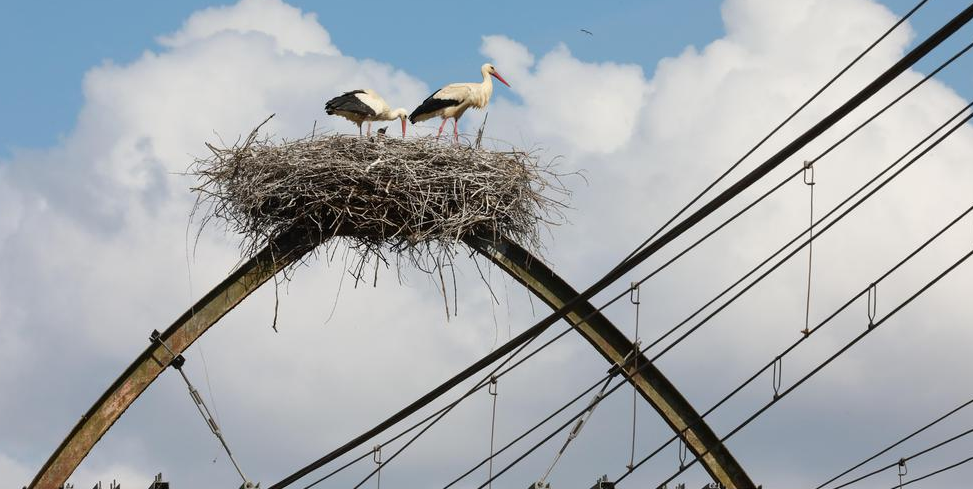
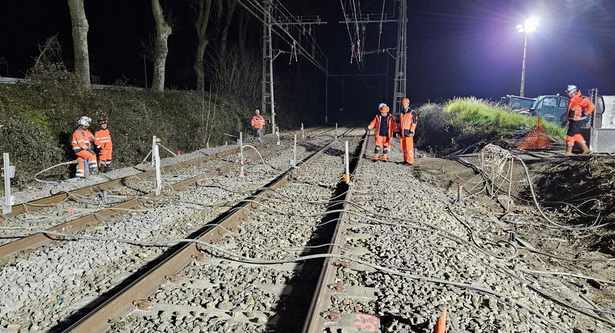
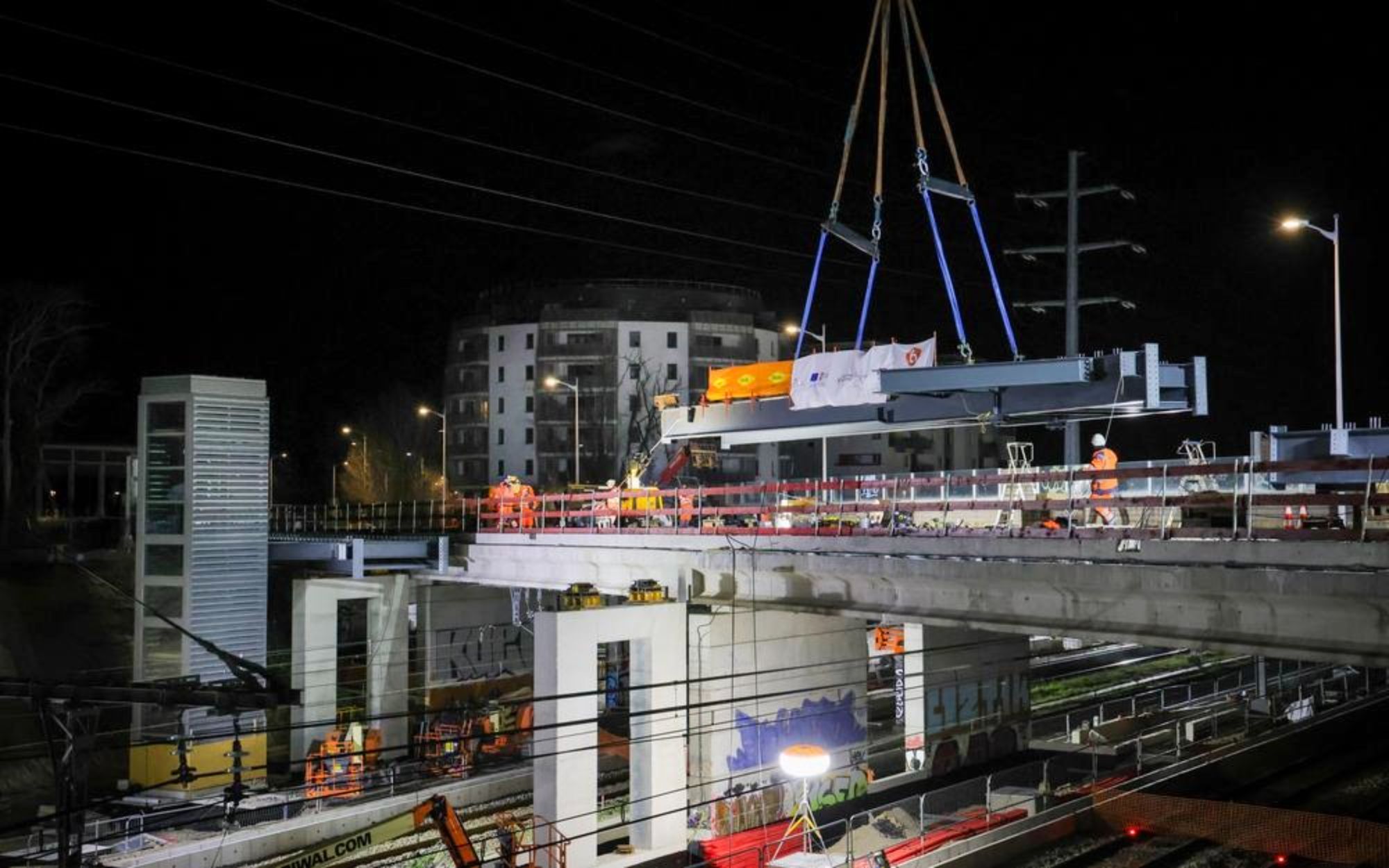
Talence footbridge
The first two weekends in March saw craning-in of the new footbridge at Talence-Médoquine, between Bordeaux Saint-Jean and Pessac. A multimodal interchange is being built at the junction of the Arcachon/Hendaye line and the Médoc branch (TER Lines 41+ and 42), where the original station was closed in 1949. The footbridge is being grafted on to the existing avenue de la Mission Haut-Brion road bridge at the country end of the platforms, together with new staircases and lifts. Opening in July, the station will be served by cross-city Line 41+ linking Arcachon with Libourne, as well as other trains terminating at Saint-Jean, giving a 15min service.
As the city SERM network develops, the intention is for Talence to take some of the pressure of interchanging passengers away from Saint-Jean. It will extend local transport opportunities and improve access to Talence-Pessac college campus and Pellegrin University Hospital once the north-south Pellegrin – Thouars – Malartic express bus route opens in 2027.
Photo: SudOuest/LT.
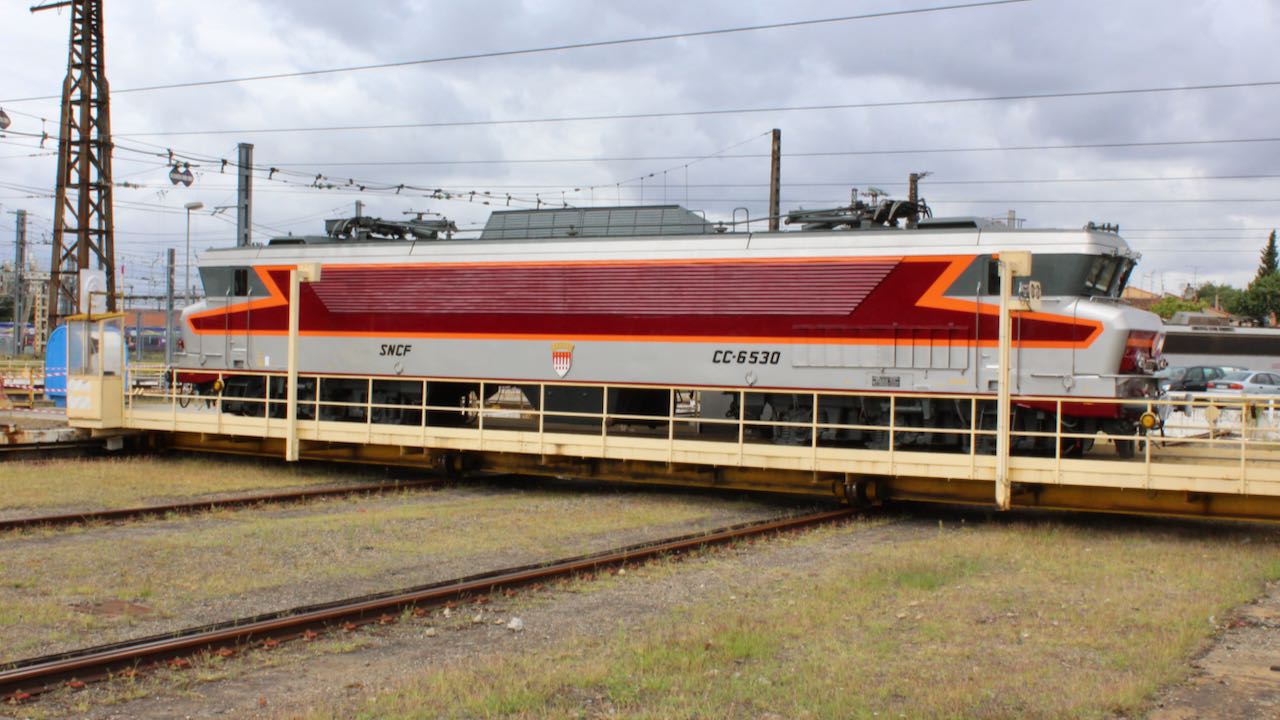
Preservation on the move
CC 6530 is seen above on the traverser at Toulouse Matabiau depot on the 18 September 2016. During March both locomotive and traverser moved onto new homes for their future preservation. The traverser has now moved to the north of France where it will be installed at CMCF (Centre de la Mine et du Chemin de Fer) Oignies. Photo: La Voix du Nord.
CC 6530 was withdrawn in December 2004 having travelled nearly 9 million km. It was then placed in the Cité du Train reserve fleet at Mohon. With the dispersal of the reserve fleet it moved to Villeneuve-Saint-Georges then Ambérieu-en-Bugey in January 2023. It has now moved on to its former depot at Paris Sud Ouest where the association 'Sauvegarde de la CC-6530' plan to restore it to full working order. Photo: Georges Turpin.
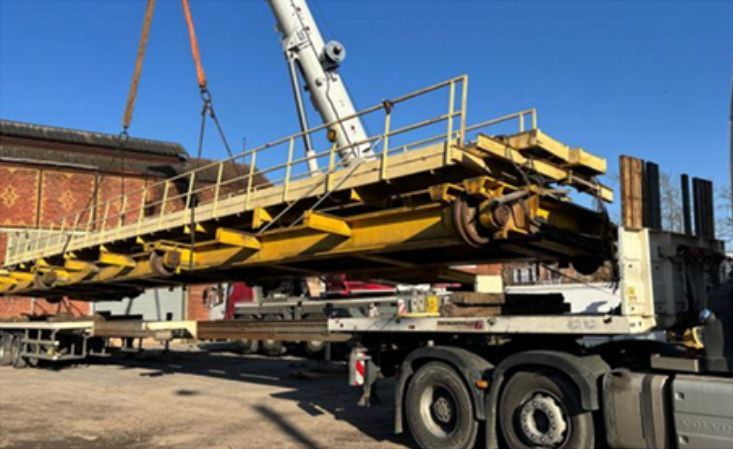
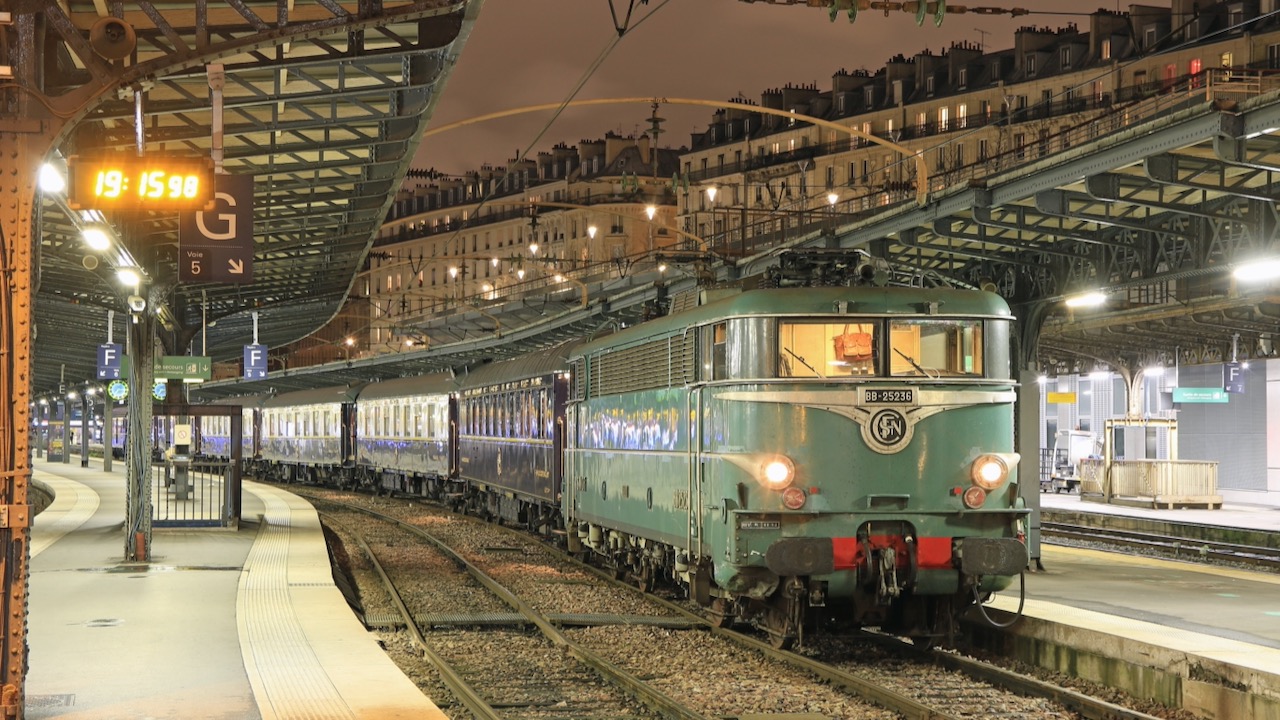
BB 25236 at Gare de l'Est on 20 January 2020 with a rake of CIWL stock from the SNCF Pulman Orient Express, soon after its return to service for CMR following overhaul at Dijon. Photo: Christophe Masse.
AAATV raising funds for three projects
AAATV-CVL has recently been entrusted with BB 25236, the only remaining dual-voltage 'Jacquemin' locomotive. It was returned to service in 2019 with CMR after an overhaul at Perrigny and worked some special trains and rolling stock movements. It is now in need of a repaint and a further overhaul, plus examination to determine the full amount of restoration needed.
Voiture Club 34 is a 1960s-era air-conditioned dining car that sported a distinctive red and grey stripe livery. Over the years it has been transformed several times into a leisure or seminar car. Funds are now being sought to restore it to its original condition, requiring repairs to its bodywork, refrigeration units and original fittings to equip it for inclusion in the Association’s historic trains.
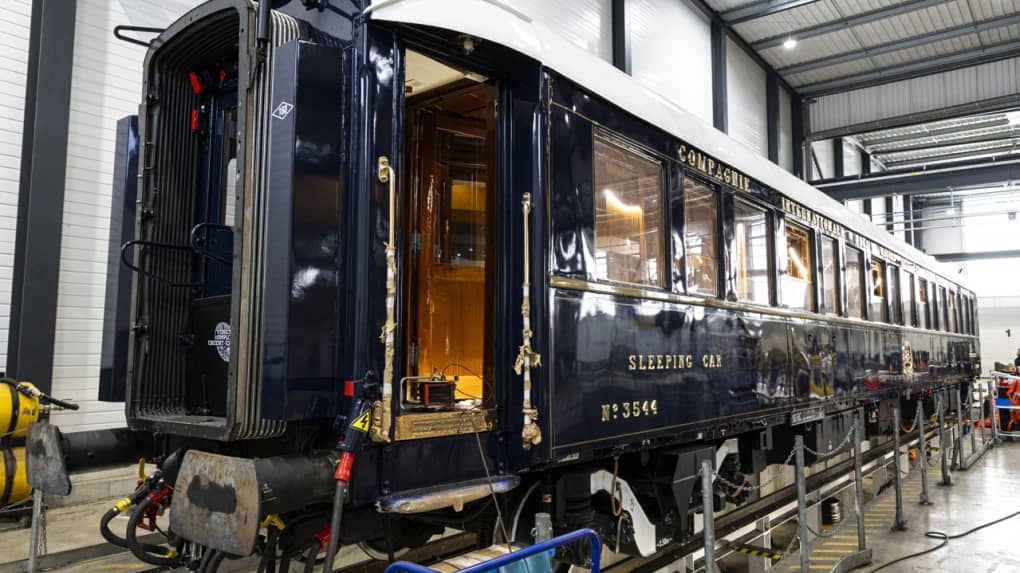
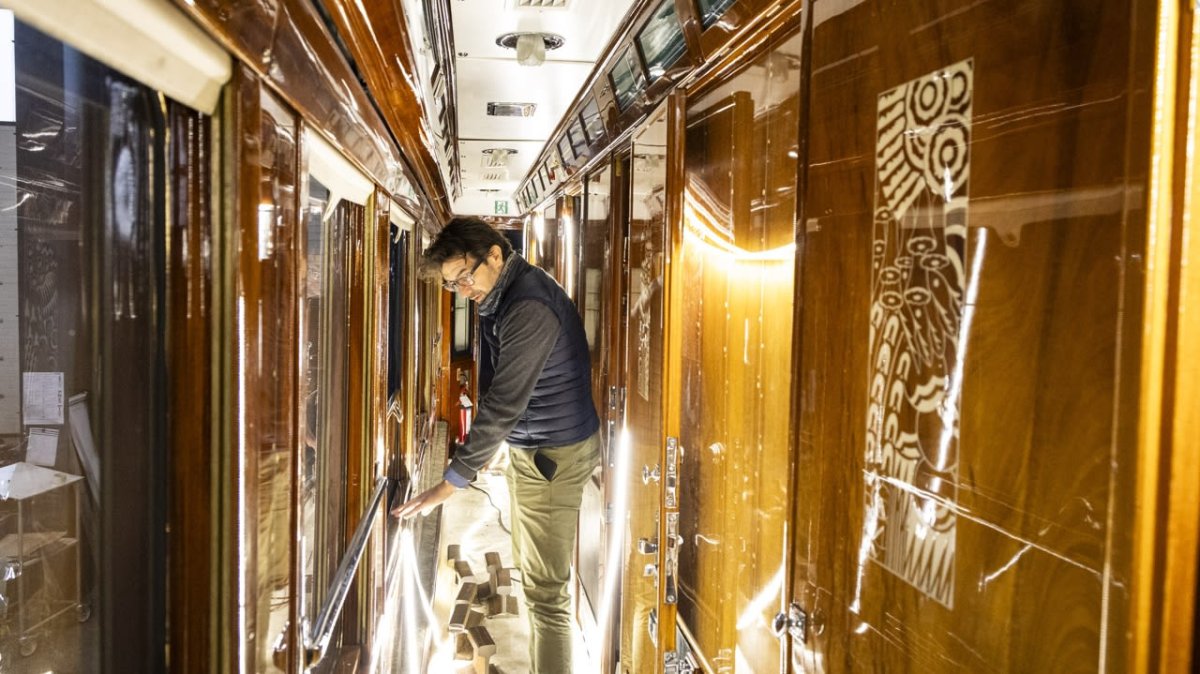
VSOE rolling stock maintenance
On 7 March Pullman Car 3544 was released from the Imateq works at Saint-Pierre-des-Corps following an R2 (four-yearly) examination and returned to Venice Simplon-Orient-Express in Paris (which is still licensed to use the name by SNCF). Built in Charente-Maritime by Aytré-La Rochelle in 1929, Car 3544 has had a varied life. Initially part of the Pyrénées-Côte d’Argent Express, it has also had two stints on Le Train Bleu, been part of the Netherlands Royal Train, and used in theRome Express and the Simplon-Orient Express.
Imateq is a specialist rolling stock maintenance company set up in 2017 by industrial railway operator Socofer and Vossloh; it is located at Saint-Pierre-des-Corps on the site of the former Magasins Généraux de la SNCF. Car 3544 arrived there last November and is the first vehicle to receive a major examination and overhaul under a five-year contract between Imateq and Venice Simplon-Orient-Express. Imateq normally deals with locomotives so the works has had to be adapted to handle hauled stock.
A further two or three vehicles will arrive in late-2025. The R2 examination covers all mechanical parts; axles, brakes, air conditioning and electrical equipment, and in the case of Car 3544 the coal-fired boiler. A specialist luxury marquetry carpenter was also employed to undertake interior repairs. The car has crank windows and VSOE is the only train still authorised to run with open windows (hence the 120km/h speed limit). Photos: © La Nouvelle République/JP.
Plougonver developments
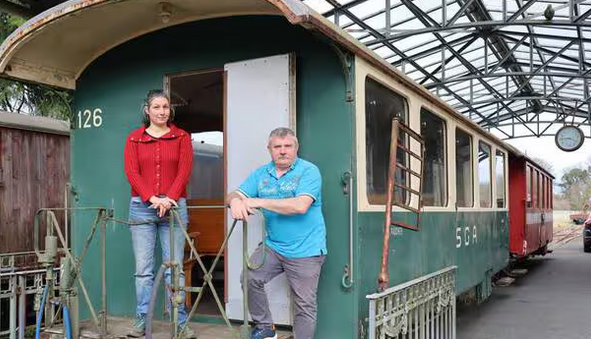
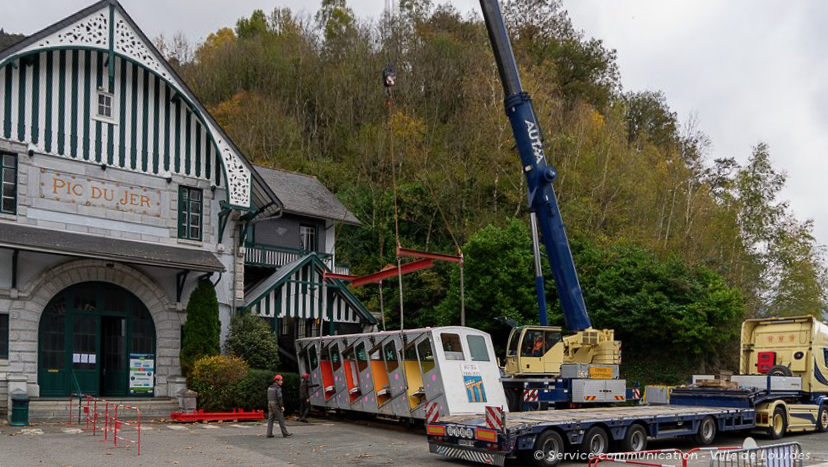
Celebrating its 125th anniversary this year, the Pic du Jer funicular at Lourdes reopens on 25 April after a major technical inspection and refit costing €528,000. As well as usual winter remedial work, the 10-yearly inspection saw the 1957-vintage cabins removed for overhaul by specialist engineers Mécamont Hydro at Lannemezan. The traction cable has been renewed and worn components replaced. Other work includes installation of handrails and safety platforms at various locations to facilitate evacuation of passengers in the event of a stoppage. The 1.1km funicular, one of the first to be built in France, rises 950m above the city, affording stunning views. Footpaths reach the summit (pic) and the start of a permanent downhill mountain bike run. An illuminated cross at the summit can be seen from afar at night. Photo: Ville de Lourdes.
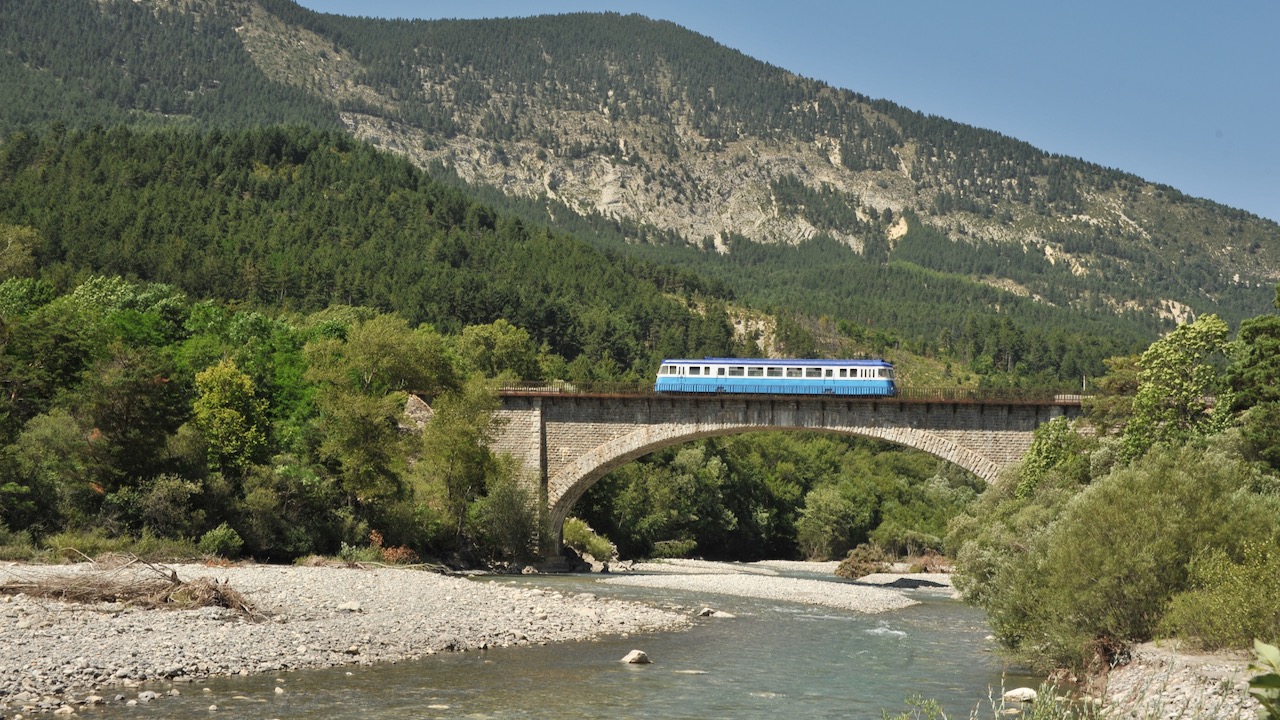
Renault autorail ZZ 6 crosses the upper Verdon valley between Thorame-Haute and Saint-André-les-Alpes on 23 July 2024.
Train des Pignes Historique - Preparing for 2025 season
Over the winter work has been underway by GECP (Groupe d’Etude pour les Chemins de fer de Provence) preparing for the 2025 season. From April until November they will operate over the Chemins de fer de Provence line mainly between Puget-Théniers – Annot, although some will travel further.
The former CfP Henschel 1200 bhp diesel (opposite) has now been fully restored and repainted in the livery of its former owner, Spanish FEVE, and will retain its former number 1404. The engine will be used for charter trains, rescue duties and rolling stock transfers for the Society.
Steam services will operate between 4 May and 8 November operated by Portugese Mallet E211. It is also hoped to have the newly restored Fives-Lille 4-6-0T E 327 (see February News) available for the Journées Européennes du Patrimoine in September. Renault ZZ 6 autorail, built in 1935, will be used for charter and public trips on the usual Puget-Théniers – Annot journey, with extra trips between Thorame-Haute and Saint-André-les-Alpes from 5 to 10 August. More information at https://www.traindespignes.fr/en/ Photos: José Banaudo.
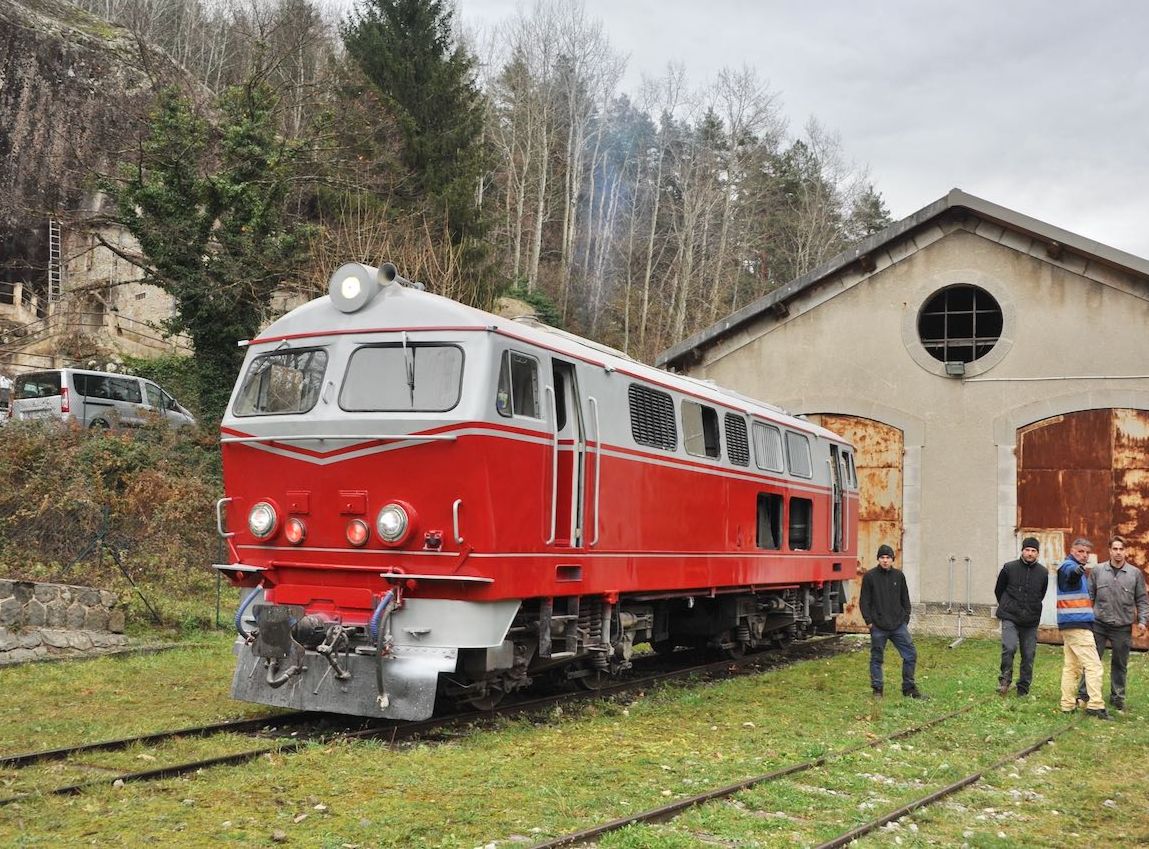
Urban News
Who will meet RATP's losses?
A row has broken out between between Jean Castex and Valérie Pécresse, the leaders respectively of Paris metro and bus operator RATP and Île-de-France Mobilités, over who will meet RATP's losses. The RATP accounts for 2024 show a €25 million deficit, a significant improvement on the loss of €109 million in 2023. RATP revenue was up at €7.1 bn compared to €6.5 bn in 2023, mainly due to the Paris Olympics and the extension of metro Lines 11 and 14 as well as the T3b tramway. While passenger volume increased by 4.3% in 2024, it is still 10% down compared to pre-covid levels, thanks to growth in home working and other options such as cycling.
RATP blames the indexation clause in its 2021 contract as not meeting the full impact of inflation. Since former prime minister Jean Castex took over as PDG of RATP, steps have been taken to dispose of loss-making subsidiaries such as London bus operations and tourist buses. Absenteeism, particularly prevalent on the bus network since covid, has been partially resolved, with an average drop of 2.5 days of sick leave per employee over the year.
For the current year, staff are unlikely to receive a pay award but metro drivers have been offered a new bonus for Saturday working in the hope that weekend service can be increased on Lines 5, 9 and 12. Proposed consolidation of other bonuses should lead to an increase in the thirteenth month’s pay and ultimately to greater pension entitlement.
In February, Jean Castex was arrested and questioned for 10 hours by police in Montpellier investigating charges of misuse of public funds and forgery. The allegations relate to when Castex was maire of the Communauté de communes Conflent Canigó in 2017, and relate to subsidies paid to a telecommunications company. The company was already under the protection of the Perpignan commercial court and the payments were made despite formal warning from the Pyrénées-Orientales prefecture. There is no suggestion that Castex benefited personally.
Punctuality. Metro, RER and Transilien punctuality improved during 2024, ÎdFM said in its annual report, the metro doing particularly well with a rise of 3.4 percentage points to 96.18%. All metro lines achieved their contractual figures except for ‘fragile’ Line 8 at only 88%. On the RER, Lines B, C and D are still below target, though Line B has improved from 85% to 88% as a result of the Ramette programme to raise train availability, deal faster with delays caused by passengers falling ill, and streamlining operations over the heavily-used section between Gare du Nord and Châtelet. Compensation will be paid to users of lines were punctuality fell below 80% for at least three months.
Eole. Following widespread teething troubles with NG EMUs in service on RER Line E, SNCF has told Alstom to suspend delivery of new trains until the problems are rectified. Failure rate is reported to be four times that of the MI2N trains being replaced. So far, 36 NG sets have been delivered out of the order for 130.
Paris Line 12. Hitachi Rail is to supply lineside communications-based train control technology for Line 12 under a contract agreed on 27 February as part RATP’s Octys train control programme. Siemens Mobility will install Trainguard MT CBTC equipment on Line 12’s trains by 2028.
Stretto. From 22 March, this consortium of SNCF Voyageurs and Keolis took over operation of Paris tram routes T4 and 11 and the Esbly – Crécy branch of Transilien Line P, now detached and run as a tram-train designated T14.
Petit Ceinture. Discussions have begun on renewal of the 10-year protocol between Ville de Paris and SNCF governing the Petit Ceinture, disused since the 1930s apart from a section absorbed into RER Line C and a twice-weekly freight working bringing materials to the Eqiom cement plant at Batignolles. Some sections are open to the public as voies vertes, while those closed off are widely used by ‘urban explorers’. It is hoped that the new agreement will permit opening of a further 4km to the public, and preserve the right-of-way for leisure purposes and possible future public transport use, rather than see parts sold for development. Following completion last year of the Line 14 extension to Aéroport d’Orly, a short section of the Petit Ceinture used for access to the construction site of Maison Blanche station is to have its track restored.
Strasbourg. Trams on Lines A and D resumed running through the tunnel at Strasbourg gare on 23 February following the collision there between two trams on 11 January. The first Citadis 1 tramcar dating from 2005 returned to service on 17 March after partial refurbishment.
All 41 first-generation cars are being overhauled in a €27 million staggered programme covering both interior and exterior renovation. Delivery of Citadis 3 cars from Alstom should start in June, with five expected to be in service in November. An option for a further 27 cars was exercised last month, bringing the number on order to 39. Photo: actuStrasbourg/IC.
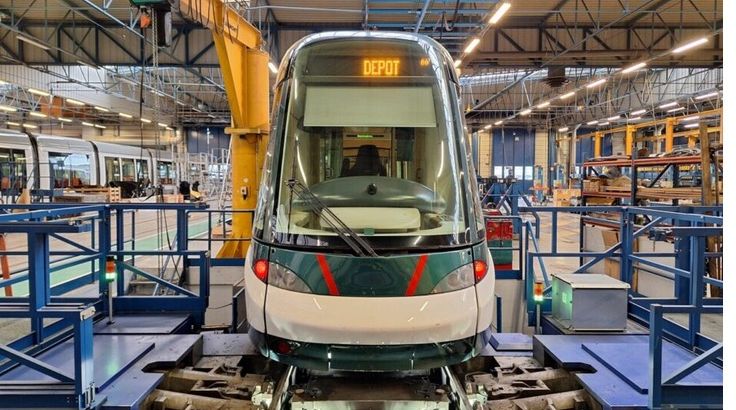
Lyon. Sytral approved plans for modernisation of Line D on 13 February, paving the way for appointment of a maître d’oeuvre and award of contracts, including for 17 new trains. Due for 2030 completion, the project will cost €339 million. Opening of tramway T9, 11.3km from Vaulx-en-Velin La Soie to Charpennes, has been delayed by six months until spring 2027.
Montpellier. The first of an order for 77 trams arrived by road from the CAF works at Bagnères-de-Bigorre on 9 March. It was presented to the public at Les Hirondelles depot on 20 March, when a maintenance shed for the new cars was inaugurated. Line 5 opens on 20 December and will be operated by 22 of the cars.
Nice. The 7.6km T5 linking Palais des Expositions with Drap now looks unlikely to be completed before 2031, a year later than planned. Public consultation is to take place later this year.
Tours. With construction of T2 expected to start in the summer for 2027 opening, SMT has awarded a contract to CAF for 19 Urbos tramcars to operate the new route.
Toulouse. From the 26 March Toulouse operator, Tisseo, will stop issuing disposable tickets. Only re-chargable tickets can be used that are swiped over a reader. They can be charged for multiple trips, and also shared and used for group travel. Tisseo will to accept payment in euros or cryptocurrency, the first European operator to do so.
Le Havre. An order was placed with Alstom on 19 March for eight Citadis cars to work on the future Line C, opening in 2027.
© Peter Lovell & Chris Bushell. The French Railways Society 2025. With thanks to Georges Turpin, Christophe Masse, Didier Delattre, Jean-Louis Poggi, David Haydock, José Banaudo and Gareth David.
